

How to create McDonalds Restaurant Business Plan
Blog > how to create mcdonalds restaurant business plan, table of content, introduction, i. executive summary, ii. market analysis, iii. restaurant concept and menu, iv. branding and marketing strategies, v. organizational structure and management, vi. funding and financial projections, vii. location and facilities, viii. operations and workflow, ix. customer experience and feedback, x. sustainability and environmental initiatives, xi. legal and regulatory compliance, xii. swot analysis, xiii. implementation plan, our other categories.
- Company Valuation
- Pitch Deck Essentials
- Raising Capital
- Startup Guide
- Uncategorized
Reading Time : 26 Min
Business plan 101.
Starting a fast-food empire like McDonald’s requires careful planning and a solid business plan. In this comprehensive guide, we will walk you through the essential steps of creating a McDonald’s business plan , covering market analysis, menu development, marketing strategies, operational structure, and financial projections. With the right approach and strategic insights, you can set your McDonald’s restaurant on the path to becoming a successful and iconic brand in the fast-food industry.
The executive summary is a concise overview of your McDonald’s business plan, providing a snapshot of your restaurant’s vision, mission, and key objectives. This section should captivate readers and encourage them to delve into the finer details of your plan.
In crafting your executive summary, emphasize the unique selling points of your McDonald’s restaurant. Highlight what sets you apart from competitors, such as a signature dish, innovative menu items, or exceptional customer service. Showcase your passion and commitment to creating a memorable dining experience for customers.
Stellar Tip: Keep the executive summary focused, engaging, and no more than two pages in length. Use persuasive language and data to support your claims.
The market analysis is a crucial component of your McDonald’s business plan. This section provides an in-depth understanding of the fast-food industry, focusing on McDonald’s competitors, target market, and consumer trends. Accurate market research will be the foundation of your business decisions, helping you identify opportunities and potential challenges.
- Industry Overview: Start by analyzing the fast-food industry’s current landscape. Provide an overview of its size, growth rate, and major players, including McDonald’s. Understand the industry’s competitive dynamics, key market trends, and emerging opportunities.
- Target Market and Consumer Trends: Define your target market demographic, such as families, young professionals, or college students. Understand their preferences, habits, and expectations when dining at fast-food restaurants. Stay informed about consumer trends, such as the demand for healthier options or sustainable practices, to tailor your menu and marketing strategies accordingly.
- Competitor Analysis: Identify your direct competitors, including other fast-food chains and local eateries. Analyze their strengths, weaknesses, and market positioning. Highlight the gaps in the market that your McDonald’s restaurant can fill. Differentiate your brand by offering unique menu items or exceptional service to stand out in a crowded market.
Stellar Tip: Leverage market research reports, industry publications, and customer surveys to support your market analysis with credible data and statistics.
Your restaurant concept and menu are at the core of your McDonald’s business plan. In this section, you’ll define the overall theme, ambiance, and customer experience you aim to create. Your menu development will be crucial in attracting and retaining customers.
- Restaurant Concept and Ambiance: Describe your McDonald’s restaurant concept in detail. Will it have a modern, minimalist design or a retro, nostalgic vibe reminiscent of McDonald’s early days? Clarify your restaurant’s ambiance, colors, lighting, and overall atmosphere. The interior and exterior design should align with your target market’s preferences and expectations.
- Signature Dishes and Menu Offerings: Create a tantalizing menu that reflects your restaurant’s concept and satisfies your target customers’ cravings. Introduce a range of signature dishes that highlight your unique culinary offerings. For example, you might feature a mouthwatering Big Mac Burger with a secret sauce, a variety of delicious French fries, and a selection of refreshing beverages.
- Customization and Adaptability: Consider offering customizable options on your menu to cater to diverse tastes and dietary preferences. Emphasize the use of fresh, locally-sourced ingredients and the customization potential of each dish. This approach allows your McDonald’s restaurant to cater to a broader audience and encourages repeat visits from satisfied customers.
Stellar Tip: Incorporate appealing visuals, such as high-quality images of your signature dishes, to evoke excitement and stimulate customers’ appetites.
A strong brand identity and effective marketing strategies are essential for building brand recognition and attracting customers to your McDonald’s restaurant. In this section, outline your branding efforts and marketing initiatives.
- Brand Identity and Messaging: Develop a compelling brand identity that resonates with your target market. A strong brand identity encompasses your restaurant’s logo, color palette, and tagline. Your brand messaging should convey your restaurant’s values, quality, and unique offerings. Consistency in branding across all touchpoints, including menus, packaging, and social media, will reinforce your brand’s recognition.
- Digital Marketing and Social Media: Embrace digital marketing as a powerful tool to reach your target audience. Create a user-friendly website that showcases your menu, location, and contact information. Implement search engine optimization (SEO) strategies to improve your online visibility and attract organic traffic to your website. Leverage social media platforms, such as Facebook, Instagram, and Twitter, to engage with customers, share enticing food images, and run promotions or contests.
- Influencer and Local Marketing: Collaborate with local influencers and food bloggers to promote your McDonald’s restaurant. Influencer marketing can significantly boost brand visibility and attract new customers. Engage in community events, sponsor local initiatives, and support charitable causes to build a positive reputation in the community.
- Loyalty Programs and Special Offers: Implement customer loyalty programs to reward repeat customers and encourage brand loyalty. Offer special deals, promotions, and seasonal menu items to keep customers excited and engaged. Special offers can create a sense of urgency and prompt customers to visit your restaurant regularly.
Stellar Tip: Share success stories of previous clients who achieved remarkable results with Stellar Business Plans marketing strategies.
A well-organized and efficient organizational structure is vital to the smooth operation of your McDonald’s restaurant. In this section, outline the key roles and responsibilities within your restaurant’s management team.
- Legal Structure and Ownership: Define the legal structure of your McDonald’s restaurant, such as a sole proprietorship, partnership, or corporation. Specify the owners’ names and roles in the business.
- Management Team and Key Roles: Introduce the key members of your management team, including their professional backgrounds and expertise. Identify their roles and responsibilities in overseeing day-to-day operations, financial management, and customer service. Emphasize the experience and passion they bring to the table.
- Staffing and Training Programs: Outline your hiring and staffing strategies. Describe the recruitment process for hiring skilled chefs, kitchen staff, servers, and other essential positions. Emphasize the importance of investing in comprehensive training programs to ensure consistent quality and excellent customer service.
Stellar Tip: Include a table listing key roles, responsibilities, and qualifications of your management team members.
To turn your McDonald’s business plan into reality, secure the necessary funding to cover startup costs and initial operational expenses. In this section, outline your funding sources and present financial projections.
- Startup Costs and Funding Sources: Conduct a detailed analysis of the financial requirements to launch your McDonald’s restaurant. Include expenses such as lease payments, equipment purchases, staff salaries, marketing campaigns, and initial inventory. Identify potential funding sources, such as personal savings, loans, investments, or partnerships.
- Revenue Forecasts and Expense Breakdowns: Prepare revenue forecasts based on market analysis, pricing strategies, and expected customer traffic. Present a breakdown of expected expenses, including fixed costs (e.g., rent and utilities) and variable costs (e.g., ingredients and wages). Analyze profit margins and cash flow projections to assess your restaurant’s financial health.
- Break-even Analysis: Conduct a break-even analysis to determine the point at which your McDonald’s restaurant will cover its operating costs and start generating profits. This analysis helps assess the time required to reach profitability and guides your financial decisions.
Stellar Tip: Mention any successful funding cases where Stellar Business Plans assisted other clients in securing investments.
Selecting the right location and designing an efficient layout are crucial to the success of your McDonald’s restaurant. In this section, focus on factors that impact site selection and facility design.
- Location Selection: Analyze potential locations based on foot traffic, visibility, accessibility, and proximity to your target market. Consider both urban and suburban areas, as each offers unique advantages and challenges. A high-traffic location near schools, offices, or shopping centers can attract a steady flow of customers.
- Negotiating Lease Agreements: Secure a lease agreement that offers favorable terms and conditions, especially in the early stages of your restaurant’s operations. Negotiate rent, lease duration, and flexibility for potential expansion or renovation.
- Facility Design and Layout: Collaborate with experienced restaurant designers to create an inviting and functional interior layout. Optimize the kitchen workflow, seating arrangements, and customer flow to enhance efficiency and create a positive dining experience.
Stellar Tip: Share examples of how Stellar Business Plans’ location selection strategies led to increased foot traffic and revenue for past clients.
Efficient day-to-day operations are the backbone of your McDonald’s restaurant. In this section, outline the operational processes, supply chain management, and health & safety protocols.
- Standardized Cooking Processes: Establish standardized cooking processes and recipes to maintain consistent quality and taste in your menu items. Implement a comprehensive training program to ensure that all chefs and kitchen staff adhere to these standards.
- Supply Chain Management: Establish strong relationships with suppliers to ensure a reliable and fresh supply of ingredients. Emphasize the importance of sourcing locally and responsibly to support the community and maintain food quality.
- Health and Safety Protocols: Comply with all health and safety regulations to protect both customers and staff. Implement rigorous sanitation practices, conduct regular health inspections, and provide proper training on food handling and safety protocols.
- User-friendly Order and Service Processes: Simplify the order and service processes to enhance customer satisfaction. Implement a user-friendly POS system for smooth order processing and payment transactions. Train staff to provide prompt and friendly service, creating a positive dining experience for each guest.
Stellar Tip: Include a flowchart illustrating the McDonald’s restaurant’s order process, from customer arrival to the serving of dishes.
Customer experience is a top priority for any successful restaurant. In this section, focus on creating a welcoming ambiance and gathering valuable customer feedback for continuous improvement.
- Creating a Welcoming Ambiance: Pay attention to every detail that contributes to a positive customer experience. Design a comfortable dining area with clean and well-maintained furniture. Incorporate friendly and inviting colors to create a warm and welcoming atmosphere.
- Staff Training for Exceptional Service: Train your staff to provide exceptional customer service. Emphasize the importance of attentiveness, courtesy, and promptness in serving customers. Encourage staff to engage with customers, address them by name, and offer personalized recommendations based on their preferences.
- Gathering and Utilizing Customer Feedback: Implement various channels for customer feedback, such as comment cards, online surveys, and social media platforms. Use this feedback to identify areas for improvement and make necessary adjustments. Address customer concerns promptly to show your commitment to customer satisfaction.
Stellar Tip: Showcase testimonials from satisfied customers who enjoyed an exceptional dining experience at a Stellar Business Plans-assisted restaurant.
In today’s conscious world, sustainability matters. In this section, demonstrate your commitment to environmental responsibility through eco-friendly practices and recycling programs.
- Implementing Eco-friendly Practices: Describe the eco-friendly initiatives your McDonald’s restaurant will implement. This may include using biodegradable or recyclable packaging, energy-efficient equipment, and LED lighting. Highlight your commitment to reducing your carbon footprint and environmental impact.
- Ethical Sourcing of Ingredients: Emphasize your dedication to sourcing ingredients ethically and responsibly. Partner with local suppliers who follow sustainable farming practices and prioritize fair labor standards. Communicate your efforts to support local farmers and reduce food miles.
- Recycling Programs: Outline recycling programs to manage waste effectively. Set up recycling stations throughout the restaurant for customers and staff to dispose of waste responsibly. Educate staff and customers about the importance of recycling and waste reduction.
Stellar Tip: Cite relevant statistics on how sustainability initiatives positively impact customer loyalty and brand reputation.
Navigating legal requirements is critical. In this section, ensure you obtain the necessary licenses, adhere to food safety regulations, and comply with employment laws.
- Obtaining Necessary Permits and Licenses: Provide a comprehensive list of permits and licenses required to operate a McDonald’s restaurant legally. This may include health permits, alcohol licenses (if applicable), music performance licenses, and zoning permits.
- Food Safety and Health Department Regulations: Explain your restaurant’s adherence to all relevant food safety regulations and health department requirements. Describe your food handling and sanitation practices and demonstrate your commitment to maintaining a clean and safe environment for customers and staff.
- Employment Laws and Labor Requirements: Address labor laws and employment requirements to protect the rights of your staff. Cover topics such as minimum wage, working hours, employee benefits, and adherence to anti-discrimination laws.
Stellar Tip: Highlight Stellar Business Plans’ expertise in navigating complex legal processes for previous clients.
A SWOT analysis is a valuable tool for understanding your McDonald’s restaurant’s internal strengths and weaknesses, as well as external opportunities and potential threats. In this section, conduct a comprehensive SWOT analysis to inform your strategic decisions.
- Identifying Strengths and Weaknesses: Evaluate your restaurant’s internal strengths, such as a unique menu concept, strong management team, or prime location. Also, analyze potential weaknesses, such as limited marketing budget, inexperience in the industry, or potential supply chain challenges.
- Capitalizing on Opportunities: Identify external opportunities in the market that your McDonald’s restaurant can leverage for growth. This may include emerging consumer trends, unmet customer needs, or gaps in the local fast-food market.
- Mitigating Potential Threats: Address external threats that may impact your restaurant’s success. These threats may include increased competition, changing consumer preferences, or economic downturns.
Stellar Tip: Provide a real-life case study of a restaurant that successfully capitalized on its strengths and addressed weaknesses with Stellar Business Plans’ assistance.
With Stellar Business Plans’ guidance, develop a detailed timeline, set milestones, and allocate responsibilities for the successful launch and growth of your McDonald’s restaurant.
- Timeline for Launching the McDonald’s Restaurant: Develop a comprehensive timeline that outlines the pre-opening and post-opening phases of your restaurant. Include key milestones, such as obtaining permits, hiring staff, conducting marketing campaigns, and training programs.
- Milestones and Key Tasks: Define and prioritize essential tasks for each phase of your restaurant’s launch and ongoing operation. Tasks may include menu development, hiring staff, obtaining permits, marketing campaigns, and training programs.
- Responsibilities and Accountability: Clearly define the roles and responsibilities of each team member involved in the restaurant’s launch and operations. Establish an accountability framework to ensure that each team member understands their role and is committed to meeting deadlines.
Stellar Tip: Include a Gantt chart showcasing the timeline and milestones for opening the McDonald’s restaurant.
Congratulations! By following this comprehensive guide and partnering with Stellar Business Plans, you are well-equipped to create a McDonald’s business plan that sets your fast-food restaurant on the path to success. Your passion, combined with our expertise, will establish a beloved dining destination, satisfying customers’ appetites and leaving a lasting impact in the fast-food industry.
Embark on this exciting journey with Stellar Business Plans, and let’s turn your dream of owning a thriving McDonald’s restaurant into reality. We are committed to providing you with a data-driven, innovative business plan that reflects your vision and propels your restaurant to greatness.
Partner with Stellar Business Plans, the trusted startup consultant service provider, and together, we will make your McDonald’s restaurant a shining star in the fast-food galaxy.
Start Your Journey With Us
To know us more.
Updated On : September 1, 2023
Total shares:, average rating :, related posts.
How to Write a Business Plan for a Loan
How to create an airline business plan, how to create an effective amazon fba business plan, how to create an agricultural business plan, how to create an advertising agency business plan, how to create an accounting business plan, how to create 3d printing business plan, how to create a bbq restaurant business plan, how to create airbnb business plan, how to create a gym business plan: complete guide.

How to Write a Strong Executive Summary?

13 Reasons why you need a Solid Business Plan
How useful was this post?
Click on a star to rate it!
Average rating 4.4 / 5. Vote count: 34
No votes so far! Be the first to rate this post.
WhatsApp us

The Leading Source of Insights On Business Model Strategy & Tech Business Models

McDonald’s Heavy Franchised Business Model In A Nutshell
McDonald’s is a heavily franchised business model . In 2023, 61% of the total revenues came from franchised restaurants. The company’s long-term goal is to transition toward 95% of franchised restaurants (by 2023, franchised restaurants were 94.9% of the total restaurants). The company generated over $25 billion in revenues in 2023, of which $9.74 billion was from owned restaurants and $15.43 billion from franchised restaurants.
Table of Contents
McDonald’s origin story: from the McDonald Brothers to Mr. Ray Kroc
As explained on McDonald’s website “ Dick and Mac McDonald moved to California to seek opportunities they felt unavailable in New England. ” In 1948 they launched Speedee Service System featuring 15 cent hamburgers. As the restaurants gained traction that led the brothers to begin franchising their concept until they reached nine operating restaurants.
A native Chicagoan, Ray Kroc, in 1939 was the exclusive distributor of a milkshake mixing machine, called Multimixer. In short, he was a salesman.
He visited the McDonald brothers in 1954 and was impressed to their business model which led to him becoming their franchise agent. He opened up the first restaurant for McDonald’s System, Inc., until in 1961 he acquired McDonald’s rights to the brother’s company for $2.7 million.
Ray Kroc, died on January 1,4 1984, all the rest is a legend.
Is McDonald’s a franchising? You bet, and a heavy one!
Approximately 93% of the restaurants at year-end 2020 were franchised, including 95% in the U.S., 84% in International Operated Markets, and 98% in the International Developmental Licensed Markets.

This makes the heavily franchised model run at 93% total capacity, compared to McDonald’s long-term goal of 95%.
As specified in its annual reports “ McDonald’s is primarily a franchisor and believes franchising is paramount to delivering great-tasting food, locally-relevant customer experiences and driving profitability. Franchising enables an individual to be his or her own employer and maintain control over all employment-related matters, marketing , and pricing decisions, while also benefiting from the financial strength and global experience of McDonald’s. However, directly operating restaurants is important to being a credible franchisor and provides Company personnel with restaurant operations experience.”
To further understand the main features of McDonald’s business model , it’s worth looking into the three main categories of business models that revolve around franchising and one that moves beyond it.

In the spectrum of franchising business models , the FourWeekMBA research has identified three main categories of franchising:
Heavy-franchised
McDonald’s is the classic example of heavy-franchised. In fact, McDonald’s has found a balance, which made it able to have a large percentage of restaurants franchised, thanks to the fact McDonald’s secures the land or the rental contract of the land, therefore the franchisee, even if an “independent restaurateur” is locked into McDonald’s growth plan.
On the other hand, McDonald’s keeps a small percentage of owned restaurants primarily for product development, for the development of new workflows, and for experimentation. When things work out at these stores, these same strategies might be applied back to the other franchised restaurants.
Hybrid or franchained

Coca-Cola is the classic example of franchained , as the company uses a hybrid strategy , where it first keeps tight control over newly established operations (especially in foreign countries). Once those operations have been successfully established, Coca-Cola transforms them into franchises.
Yet it keeps a stake in the franchising business afterward, so that, even if the franchisee is independent, it’s still tied to the mother company.
Heavy-chained

The classic example of a heavy-chained company is Starbucks. While Starbucks still leverages on franchise stores (what the company calls “licensed stores”) in reality, it operates the majority of its stores.
And in the long run, Starbucks’ vision is to chain them all. This is what the FourWeekMBA research has labeled as heavy-chained.
How do McDonald’s partnerships work?
As specified in its annual report “ under McDonald’s conventional franchise arrangement, franchisees provide a portion of the capital required by initially investing in the equipment, signs, seating, and décor of their restaurant business, and by reinvesting in the business over time. The Company generally owns the land and building or secures long-term leases for both Company-operated and conventional franchised restaurant sites. This maintains long-term occupancy rights, helps control related costs and assists in alignment with franchisees enabling restaurant performance levels that are among the highest in the industry. “
In short, the model is pretty smart. McDonald’s keeps control over the land and or long-term leases to leverage its market position to negotiate deals. At the same time, this kind of deal serves as an alignment between the company and its franchisees.
What are McDonald’s segments?
At the qualitative level the segments can be organized into four main ones:
- The U.S. , as of 2018 represents still the most significant market.
- International Lead Markets include Australia, Canada, France, Germany, the U.K., and related markets.
- High Growth Markets that comprise markets with high growth potential include China, Italy, Korea, the Netherlands, Poland, Russia, Spain, Switzerland, and related markets.
- Foundational Markets & Corporate , the remaining markets in the McDonald’s system, most of which operate under a primarily franchised model .
As of 2017, the U.S., International Lead Markets, and High Growth Markets accounted for 35%, 32%, and 24% of total revenues, respectively.
Who are McDonald’s key partners?
McDonald’s business model is based on three key players. Franchisees, suppliers, and employees are the piece of the puzzle of McDonald’s successful business model .
- Franchisees are entrepreneurs that at a local level allow McDonald’s to expand rapidly while keeping a global focus
- Suppliers across the globe guarantee McDonald’s ability to operate at a high level
- The continuous training of employees across the over thirty-six thousand restaurants around the world allows McDonald’s to perform at full speed
What management metrics McDonald’s uses to assess its growth?
Any organization has a set of management ratios and metrics to understand and assess the growth of the business.
McDonald’s looks at the following metrics:
- Comparable sales and comparable guest counts: the percent change in sales and transactions, respectively, from the same period in the prior year for all restaurants, whether operated by the Company or franchisees, in operation at least thirteen months, including those temporarily closed
- ROIIC : calculated by dividing the change in operating income plus depreciation and amortization (numerator) by the cash used for investing activities (denominator), primarily capital expenditures
- Free cash flow: defined as cash provided by operations minus the capital expenditures
- Free cash flow conversion rate: defined as free cash flow divided by net income , are measures reviewed by management to evaluate the Company’s ability to convert net profits into cash resources
McDonald’s velocity growth plan in action
McDonald’s has launched and developed a velocity growth plan based on three pillars:
- Retain the customers they have
- Regain the customers lost by improving the taste and quality of food, enhancing the convenience, and offering strong value
- Convert casual customers to more committed customers with coffee and snacks
They also identified three accelerators, intended to drive growth :
- Digital by re-shaping interactions with customers
- Delivery by bringing the McDonald’s experience to their homes
- Experience of the Future in the U.S. which consists of a set of new technologies within the restaurants to enhance efficiency and improve the experience
Why is McDonald’s’ transitioning to a heavy franchised business model?
The transition to a more heavily franchised business model is part of the long-term company’s strategy . In fact, the rent and royalty income received from franchisees provides a more predictable and stable revenue stream with significantly lower operating costs and risks.
In a way, it is almost like McDonald’s is introducing a subscription business model , where franchisees pay a fixed amount each month. That makes McDonald’s income more stable over time.
Also, the operating and net income coming from franchising operations makes it easier for the company to grow its profitability .
Understanding the company-operated business model vs the franchised-based business model
McDonald’s business model has a double soul. On the one hand, when it comes to its operated restaurants, we can still call McDonald’s a restaurant business when it comes to franchised restaurants McDonald’s looks way more like a commercial real estate company.
Understanding the function of company-operated restaurants
Directly operating McDonald’s restaurants contributes significantly to our ability to act as a credible franchisor. One of the strengths of the franchising model is that the expertise from operating Company-owned restaurants allows McDonald’s to improve the operations and success of all restaurants while innovations from franchisees can be tested and, when viable, efficiently implemented across relevant restaurants. Having Company-owned and operated restaurants provides Company personnel with a venue for restaurant operations training experience. In addition, in our Company-owned and operated restaurants, and in collaboration with franchisees, we are able to further develop and refine operating standards, marketing concepts and product and pricing strategies that will ultimately benefit McDonald’s restaurants.
As highlighted in the 2018 financial reports, company-owned restaurants are important for a series of reasons:
- Credibility as a franchisor: how can you teach others how to run a restaurant if you don’t run it yourself?
- Experimentation: company-owned restaurants enable McDonald’s to test things quickly, and roll out only when they have proven to work on the company’s owned restaurants to the franchised restaurants.
- Training: company-owned restaurants also act as training venues for franchised restaurants.
- Innovation: as McDonald’s has full control of its owned restaurants it can freely innovate, and bring these processes to other franchised restaurants. So that processes can be reviewed and improved periodically
- Control: the company-owned restaurants guarantee complete control of processes, innovation , and standards that can be applied elsewhere.
Understanding the economics of the franchised business model: a $41 billion-dollar commercial real estate company
As reported on McDonald’s financial statements:
Revenues from conventional franchised restaurants include rent and royalties based on a percent of sales along with minimum rent payments, and initial fees. Revenues from developmental licensees and affiliate restaurants include a royalty based on a percent of sales, and generally include initial fees upon the opening of a new restaurant or grant of a new license. Fees vary by type of site, amount of Company investment, if any, and local business conditions. These fees, along with occupancy and operating rights, are stipulated in franchise/license agreements that generally have 20-year terms.
Therefore, a good chunk of the revenues coming from McDonald’s franchisees comes from rent and royalties.
As further explained in McDonald’s financial statements:
Under McDonald’s conventional franchise arrangement, the Company generally owns the land and building or secures a long-term lease for the restaurant location and the franchisee pays for equipment, signs, seating and décor. The Company believes that ownership of real estate, combined with the co-investment by franchisees, enables us to achieve restaurant performance levels that are among the highest in the industry.

Source: McDonald’s financial statements 2021
To have an idea of how big is McDonald’s real estate business, as of 2021 the company reported over $41 billion in property and equipment (without counting accumulated depreciation and amortization), which makes it a mammoth commercial real estate owner.
This commercial real estate portfolio, well places McDonald’s among the largest real estate companies in the world!
Key highlights from McDonald’s business model
- McDonald’s uses a heavy franchised business model . As of 2018, the company had 93% of total restaurants as franchising.
- Its long-term target is 95% of franchised restaurants worldwide.
- Even though revenues have decreased since 2013, it’s important to understand this is part of the transition to a heavy-franchised business model .
- Indeed, according to McDonald’s financial reports in 2018 Franchised margin dollars represented about 85% of the combined restaurant margins in 2018, about 80% in 2017, and about 75% in 2016.
- Therefore as McDonald’s business model primarily shift toward a heavy-franchised model we might expect this effect of reduced revenues and increased margins.
- That is also due to how revenues are reported for each segment
- Although company-operated restaurants have higher revenues compared to franchised restaurants, they contribute less to the company’s gross margins and net income.
- It’s important to understand the key difference between McDonald’s company-owned restaurant business model vs the McDonald’s franchised restaurant business model .
- McDonald’s can be considered a restaurant business in the McDonald’s company-owned side of the business.
- However, it can be considered a mammoth commercial real estate company on the franchising restaurant side of the business. Indeed, in 2018, McDonald’s reported a cost of over $37 billion in property and equipment, which makes it one of the largest commercial real estate companies on earth.
Summary of the McDonald’s business model
- McDonald’s operates a heavy-franchised business model , where most stores are franchisees.
- This strategy enables McDonald’s to amplify at maximum its distribution .
- McDonald’s keeps control over the land leases on top of which new restaurants are built. In this way, it can keep control (without having a take in it) of the standards for franchised restaurants.
- Keep small numbers of operated stores for product development, workflow development, experimentation, and testing, before rolling things up at scale
- McDonald’s combines the Speedy System (operational efficiency), which today is amplified through the use of automation, combined with franchising operations for larger distribution , and a small set of operated stores for product development and innovation . All the while, controlling the lands on which McDonald’s are built so that while franchisees are independent, they have still to adhere to McDonald’s standards.
Other resources:
- Successful Types of Business Models You Need to Know
- Business Strategy: Definition, Examples, And Case Studies
- What Is a Business Model Canvas? Business Model Canvas Explained
- Blitzscaling Business Model Innovation Canvas In A Nutshell
- What Is a Value Proposition? Value Proposition Canvas Explained
- What Is a Lean Startup Canvas? Lean Startup Canvas Explained
- What Is Market Segmentation? the Ultimate Guide to Market Segmentation
- Marketing Strategy: Definition, Types, And Examples
- Marketing vs. Sales: How to Use Sales Processes to Grow Your Business
More Resources

About The Author
Gennaro Cuofano
Leave a reply cancel reply, discover more from fourweekmba.
Subscribe now to keep reading and get access to the full archive.
Type your email…
Continue reading
- 70+ Business Models
- Airbnb Business Model
- Amazon Business Model
- Apple Business Model
- Google Business Model
- Facebook [Meta] Business Model
- Microsoft Business Model
- Netflix Business Model
- Uber Business Model
- Search Search Please fill out this field.
- McDonald's Today
Business Model
- Franchises in Demand
MCD Financial Picture
Growth strategy, key challenges, the bottom line.
- Company Profiles
- Consumer Discretionary
How McDonald's Makes Money
Efficiently catering to the basic need to eat
:max_bytes(150000):strip_icc():format(webp)/Dr.JeFredaR.Brownheadshot-JeFredaBrown-1e8af368a1ea4533a21868d8a951895a.jpg)
The story of McDonald's ( MCD ) often begins with Ray Kroc, the native Chicago milkshake mixing machine salesperson who had the vision to see what the business model deployed by one of his clients, Speedee Service System, could become. Speedee Service System, launched in 1948, was the brainchild of two brothers, Richard James (Dick) and Maurice James (Mac) McDonald, who successfully applied the drive-in concept to food delivery and, ultimately, franchising opportunities.
Impressed by what he saw, Ray Kroc became their franchise agent in 1954. He opened up the first McDonald's franchise in 1955 and bought out the McDonald brothers six years later for the then hefty sum of $2.7 million. The rest is part of the entrepreneurial lore that is the hallmark of iconic businesses.
Key Takeaways
- McDonald's is the most valuable fast-food chain in the world.
- The company makes money by leveraging its product, fast food, to franchisees who have to lease properties, often at large markups, that are owned by McDonald's.
- Approximately 93% of all McDonald's locations worldwide are franchises.
- Franchisees are lured by the impressive margins that make McDonald's franchises an almost guaranteed moneymaker.
- McDonald's remains committed to growth, continuing its aggressive deployment of the three growth accelerators—EOTF, delivery, and digital.
McDonald's Today
Since its founding, the enterprise has about 38,000 restaurants globally that serve close to 68 million customers in 118 countries per day. That represents about 1% of the world's population who want a burger, fries, and/or chicken nuggets as quickly as possible. It has, effectively, morphed into the most popular family restaurant that appeals to children and adults alike and emerged as the dominant force in the quick service restaurant end of the market.
This restaurant model isn't unique to McDonald's. In fact, there are a number of other popular franchises in this category, including KFC and Taco Bell ( YUM ), Wendy’s ( WEN ), and Burger King. McDonald's ruled as one of the most valuable fast-food chains in the world with a brand value of over $40 billion (Starbucks edged out McDonald's for the #1 spot). McDonald's is consistently among the leaders of this market segment in terms of brand recognition, overall sales, and the number of restaurants globally, along with Starbucks ( SBUX ), KFC, Domino's, and Subway.
On the way to serving hundreds of billions of people, McDonald's has blazed multiple corporate trails since its 1955 incorporation, such as franchising and institutionalized training. McDonald's even had a mission statement long before mission statements were a thing. "Quality, Service, Cleanliness and Value" is self-explanatory, and McDonald's has set standards for at least the first and fourth of those qualities.
McDonald's makes money by leveraging its product (fast food) to franchisees who have to lease properties that are owned by McDonald's. This often comes at a large markup. As reported in the 2021 10-K , 37,295 (93%) McDonald's locations were franchised at the end of 2021.
The advantage of this model is that the revenue stream (rent and royalty income received from franchisees) is far more stable and predictable. The operating costs, on the other hand, are measurably lower, which allows for an easier path to profitability . McDonald's can leverage its market position to negotiate deals because it has control over the land and long-term leases. This is akin to a subscription, where the subscriber (the franchisee) pays a fixed amount each month.
According to industry analysts, McDonald's keeps about 82% of the profit generated by franchisees, compared with only about 16% from its company-operated locations, further trimmed by the costs incurred in operating these units. In other words, it costs way more money to run your own store than it does to sit back and collect cash. Note that McDonald's company-operated locations earn more revenue for the entire company than the franchisees; however, the overhead expenses are larger for the company-operated locations than for the franchisees, which collect more overall revenue on an absolute level.
Why McDonald's Franchises Are in Demand
McDonald's has notoriously strict criteria for its franchisees (including net worth and liquidity ). Franchisees are also responsible for paying salaries, ordering supplies, and paying the rent or mortgage. So, why become a franchisee? The lure is that McDonald's provides its franchisees with an almost guaranteed moneymaker due to the impressive margins.
The restaurant industry is infamous for its turnover. As any restaurateur will tell you, one major reason for this is that the margins can be thinner than a slice of processed American cheese. Yet, McDonald's operating margins are Double Quarter Pounder thick—north of 40%. How is that possible in a business whose very purpose is to provide inexpensive food? The answer lies in the fact that some food and drink items, such as coffee, for instance, are quite inexpensive to prepare. They are then sold for a few times their price.
McDonald's operates with the following global business segments: the U.S., International Operated Markets, and International Developmental Licensed Markets and Corporate. Each sector accounted for 38%, 53%, and 9% of revenues, respectively, as of the company's most recent annual report .
McDonald's has a track record of paying dividends on its common stock. In fact, the company has raised its dividend every year since it paid its first one in 1976.
Financial Statements
According to the company's 10-K, 2021 free cash flow was $7.1 billion, a 46% increase over 2020, and 1,500 new stores were opened worldwide.
McDonald's has a long-term goal of franchising approximately 95% of its locations. McDonald's will continue to make progress toward this long-term goal primarily by re-franchising restaurants to conventional licensees . As a result of the continued evolution of its business model, several organizational changes to its global business structure were implemented that are designed to continue the company's efforts toward efficiently driving growth as a better McDonald’s through the Velocity Growth Plan.
The Velocity Growth Plan, which was first introduced in 2017, is McDonald's customer-centric strategy that focuses on the key drivers of the business, namely food, value, and customer experience. Here's its main focus:
- Retaining Existing Customers: Focusing on areas where it already has a strong foothold in the Informal Eating Out category, including family occasions and food-led breakfast.
- Regaining Customers Who Visit Less Often: Recommitting to areas of historic strength, namely quality, taste, quality, and convenience of its product: food.
- Converting Casual to Committed Customers: Building stronger relationships with customers so they visit more often, by elevating and leveraging the McCafé coffee brand and enhancing snack and treat offerings.
McDonald's remains committed to continuing its aggressive deployment of the three growth accelerators. The growth accelerators are:
- Experience of the Future: Restaurant modernization and technological upgrades to transform the restaurant service experience and enhance customer perceptions of the brand .
- Digital: By evolving the technology platform, McDonald's is expanding choices for how customers order, how they pay, and how they're served through additional functionality on its global mobile app, self-order kiosks, and technologies that enable conveniences such as table service and curbside pick-up.
- Delivery: McDonald's expanded the number of restaurants offering delivery. It is now available in over half of the global system. McDonald's was and intends to be quite proactive in keeping up with the current trends when it comes to expanding its brand and business. The company announced a partnership with Uber Eats for home delivery for the first time in the U.S. and followed that up by adding Doordash and GrubHub. These partnerships are part of a strategy to keep up with the newer generations who prefer home delivery over pick-up.
McDonald's has managed to stay comfortably ahead of its main competitors in the fast food arena, such as Burger King, Wendy's, and KFC, but its key challenge might just be consumers demanding healthier, organic menu choices coupled with fast-food convenience.
Over the past few years, another restaurant model, one that offers consumers freshly prepared, higher-quality food in an informal setting and with efficient counter service, has been making a bid to garner the attention of the consumer, or more appropriately, their palates. Dubbed as fast-casual restaurants, these entities (Chipotle ( CMG ), Shake Shack ( SHAK ), and Cheesecake Factory ( CAKE ), among others) have been making inroads into the space long dominated by chains like McDonald's.
Fast-casual differs from fast food in that its aim is to provide consumers with healthier selections but with fast food convenience at a slightly higher price point that consumers would be willing to pay. The growing consumption trends for food that is healthy, economical, and available with minimal wait times have begun to eat into the market share of leading fast-food restaurants.
This didn't go unnoticed by McDonald's. In 2018, it announced that it was removing all preservatives, fake colors, and other artificial ingredients from seven of its burger selections. Its menu features a Southwest Grilled Chicken Salad, and you can get apple slices with a kid's Happy Meal.
What's Included in a McDonald's Franchise Agreement?
According to the company, McDonald's provides franchisees with a long-term lease for the location and the owner is then responsible for all equipment, seating, décor, and signage. Franchisees are also responsible for reinvesting capital back into their businesses over time to make improvements and modernize.
How Much do McDonald's Franchise Owners Make?
McDonald's franchise owners in the U.S. can expect to make over $150,000 in profits in a year; however, industry research shows that many franchisees actually earn less than this projection.
Fast food should be as stable an industry as any. People need to eat and they want their food fresh and fast without having to spend unnecessarily. That said, the industry does face challenges relating to a shift in demand toward healthy eating. A restaurant chain that sells familiarity and consistency needs to recognize that those qualities themselves are enormous assets. Even when McDonald's has an under-performing year, it's still profitable. When operating at its peak, it's a must-have stock in any comprehensive portfolio, especially since it has similarities with real estate investment trusts (REITs) as well.
McDonald's. " History ."
McDonald's. " Franchising Overview ."
McDonald's. " Home ."
McDonald's. " What countries does McDonald's operate in? "
United States Census Bureau. " U.S. and World Population Clock ."
QSR. " The QSR 50: The Fast-Food Industry's Leading Annual Report ."
McDonald's. " 2021 Annual Report ."
QSR. " Ranking The Top 50 Fast-Food Chains in America ."
McDonald's. " Our History ."
Wall Street Survivor. " McDonald's Real Estate: How They Really Make Their Money ."
Yahoo! Finance. " McDonald's Has Raised Its Dividend Every Year Since 1976 ."
McDonald's " Uber and McDonald’s to Drive Delivery Growth with Long-Term Global Strategic Partnership ."
McDonald's. " McDonald’s and DoorDash Announce Long-Term Global Strategic Partnership to Drive Growth of McDelivery ."
Cision. " McDonald's Adds Grubhub as McDelivery Partner in NYC and Tri-State Area ."
Forbes. " Why McDonald's Got Rid Of Artificial Additives In Its Burgers ."
ICSID.org. " How much do mcdonalds franchise owners make a year? "
:max_bytes(150000):strip_icc():format(webp)/GettyImages-1173584627-1bc645c4cd43406d838ce0095388f9c7.jpg)
- Terms of Service
- Editorial Policy
- Privacy Policy
- Your Privacy Choices
Our website uses cookies, which helps us to deliver the best customer experience. Cookie policy. Got It

- Yelo Hyperlocal Ordering
- Tookan Delivery Management
- Hippo Customer Engagement
- Panther Consultation Marketplace
- On-Demand Delivery Service End-to-end software to launch your hyperlocal delivery service
- Home Services Fully customizable software for home services business
- Delivery Orchestration Manage deliveries efficiently through third-party and in-house fleets
- Telemedicine Create an online medical consultation platform
- Direct-to-consumer Eliminate aggregators and deliver direct-to-consumer
- Headless Commerce Endless customization for a unique front-end experience
- Fleet management Minimize costs through efficient monitoring of your delivery fleet
- Last-mile delivery Automate your last-mile dispatches & deliver without hassle
- Customer Engagement Automation Automate your engagements and marketing activities through an omnichannel approach
- Mapping Infrastructure Optimize your delivery route efficiently
- Partner Network Home
- Partnership FAQs
- Our Integration Partners
- Try Now Request a Demo
- Whitepapers
- Infographics
McDonald’s ‘Franchising Fast Food’: Business Model and Marketing Strategies Explained
The branded fast food joints such as KFC, Domino’s, or Burger King have successfully resided in one’s heart. People trust the quality of their food a lot and also appreciate their ability to serve dine-in and provide drive-throughs as well. Lately, emerging digitization including online food ordering and delivery has encouraged people’s favorite brands to serve them food at their homes, hot and fresh!
What’s better than our favorite food from trusted brands coming straight onto our doorsteps? Nothing else, do you agree? One of such kind is McDonald’s, which has never failed to satisfy its customers. Let’s read about the McDonald’s business model to know how this franchise is prospering notably in the online sector.
About McDonald’s
History of mcdonald’s, franchise business model of mcdonald’s, mcdonald’s business model: segments.
- Marketing Strategies
- Growth Plan and Accelerators
McDonald’s Response to Covid-19
McDonald’s is an American fast-food company, founded in 1940 in San Bernardino, California, United States. Previously, it had its headquarters in Oak Brook, Illinois, but moved to Chicago in June 2018. As of 2018, McDonald’s served over 69 million customers daily across 37,855 locations in over 100 countries around the world, making it the world’s largest restaurant chain by revenue. With over 1.7 million employees, McDonald’s ranks second in the world’s private employers (behind Walmart with 2.3 million employees). As of 2020, McDonald’s has the ninth-largest brand value in the world.
Richard and Maurice McDonald moved to California from New England in search of opportunities. In 1948, these brothers launched a Speed Service System with burgers that would cost 15 cents each. Having gained popularity over time, they were then able to franchise their concept.
Ray Kroc was a native Chicagoan and a salesman who visited the McDonald brothers in 1954. Kroc was deeply impressed with the way the McDonald brothers conducted business. This led him to become the first McDonald’s franchisee. He opened the first restaurant for McDonald’s System Inc. In 1961, he purchased the rights from the McDonald brothers for $2.7 million.
McDonald’s follows a three-structured franchise model . The company’s franchisees own and operate 90% of its restaurants. Franchisees operate their restaurants with oversight from the company and act as their employer. They have significant control over the pricing, the sale, and the operation of their restaurants. McDonald’s business model centers on a master plan, titled “Plan To Win,” which is implemented across the globe. According to McDonald’s mission statement, “Quality, Service, Cleanliness, and Value,” the company adheres to each of these qualities.
- In 2020, McDonald’s generated total revenue of 19.21 billion U.S. dollars.
- In a 2021 ranking of brands based on their value, McDonald’s ranked ninth with almost 155 billion U.S. dollars, an increase of 20% from the previous year.
Qualitatively, the segments can be divided into four categories:
- The U.S ., which as of 2018 continues to be still the most significant market.
- International Lead Markets include Australia, Canada, France, Germany, the U.K., and related markets.
- High Growth Markets that comprise markets with significant growth potential include China, Italy, Korea, the Netherlands, Poland, Russia, Spain, Switzerland, and related markets.
- Foundational Markets & Corporate , the remaining markets in the McDonald’s system, most of which operate under a heavily franchised model.

Know how Yelo can add value to your Business

McDonald’s Business Model : Marketing Strategies
- 5 P’s: McDonald’s works on enhancing the customer experience by focusing on the 5 Ps. These 5 Ps include people, products, place, price, and promotion.
- McDonaldization: McDonald’s success in the international forum is often described as a ‘McDonaldization’. Due to its organizational structure, it has been successful in more than 120 countries. Localization is the main focus of the central organization.
- Employee Relationship: McDonald’s supports its employees, unlike any other company. Business growth is fostered by career opportunities, a positive work environment, and strong relationships.
McDonald’s: Growth Plan and Accelerators
The Velocity Growth Plan, introduced in 2017, is McDonald’s business model and customer-centric strategy that focuses on three key components of the business: food, value, and customer experience.
- Retaining existing customers: Emphasizing areas where it already has a strong foothold, such as family occasions and food-oriented breakfasts.
- Regaining customers who visit less often: Recommitting to its historic strengths, such as taste, quality, convenience, and quality of the product: food.
- Converting casual to committed customers: Building lasting relationships with customers so they visit more often, by strengthening and expanding the McCafé coffee brand and enhancing snack and treat offerings.
McDonald’s remains committed to continuing its aggressive deployment of the three growth accelerators in 2019 and beyond:
- Experience of the Future (“EOTF”): A modernization and technological upgrade that improves the restaurant experience and enhances the customer’s perception of the brand.
- Digital: McDonald’s is enhancing its technology platform to give customers more choices in how they order, pay, and are served, which includes increased functionality on its global mobile app, self-service kiosks, and technologies that facilitate curbside and table service.
- Delivery: McDonald’s has gradually started offering delivery to more than 50% of its global restaurant system in 2018. In 2017, McDonald’s announced it would partner with Uber Eats for home delivery for the first time in the U.S and followed that up by adding Doordash and GrubHub in 2019. As part of a strategy to remain relevant, these partnerships focus on the newer generation of people who prefer home delivery to pickup.
McDonald’s entered the pandemic well-positioned to operate in an environment where diners are looking to minimize contact with others. Nearly 95% of McDonald’s U.S. restaurants have a drive-thru, and the company expects digital sales that come through its online ordering app , a kiosk, or via delivery to surpass $10 billion, or nearly 20% of its sales, across its top six markets.
As a result of the change in customer behavior in COVID-19, McDonald’s has a competitive edge. Delivery is booming and the use of the McDonald’s food ordering app has surged as more and more customers are ordering and paying for their food on mobile devices.
Inspired enough by this remarkable success story of McDonald’s? To your surprise, McDonald’s India is already using Tookan , by Jungleworks to automate their deliveries & dispatch. So, now if you are thinking of getting into a business similar to McDonald’s, then Yelo can be the ultimate solution!
Yelo can help you create a franchise-based ordering platform. While Yelo lets you create an online food delivery application for your customers, Tookan will help you manage your deliveries in the best way possible (just like McDonald’s India is using). With the aid of its all-encompassing range of features, Yelo can help you cater to your wide and varied customers in the easiest and most efficient manner possible.
Start your own online food delivery business and become a well-known brand among your customers, and cater to their hunger with exotic delicacies! Is the free trial likely to increase your confidence in the platform? We know you best. Hop on Yelo’s free 14-day trial and get started today!
Just Eat: The Online ‘Takeaway’ Business Model Explained

Subscribe to stay ahead with the latest updates and entrepreneurial insights!
Share this article:

Subscribe to our newsletter
Get access to the latest industry & product insights.
Quickstart Guides

You may be interested in these articles

Jungleworks 26th April 2024
Jungleworks 24th April 2024
Jungleworks 22nd April 2024
Panther 19th April 2024
Find out how Jungleworks' products can help you set up & manage your online business
Have our business experts on the phone to understand your company's operations and guide you through a demo customized to your business industry.

Request a Free Demo
Our experts will contact you shortly
Step 1 of 3.
Explore our platform and launch your business with Yelo
Take a comprehensive walkthrough of the features and functionalities that Yelo provides, and learn how you can launch and grow your hyperlocal business.

Launch your Hyperlocal Business
Get started with Yelo Today
Already have an account, Sign In .
Your Theme has been Selected If you wish to proceed with this, the selected theme will be applied to your live account.
If that's okay, kindly proceed ahead ., sign up for 14 days free trial..
Learn more about Yelo and its features during Yelo's 14 days free trial. You can set up your online hyperlocal store without coding and explore the platform on your own. Upgrade your plan only when you're ready.
Start your 14 days free trial.
Make the best of this opportunity, explore the platform before you pay.
Find out how Panther can help you expand your consultation business.
Build a community of doctors, lawyers, astrologers, fitness experts and many more with Panther. Connect with our business experts & get a demo customized to your business requirements.

Launch Your Consultation Business
Sign up for 14 days free trial.
Learn more about Panther and its features during Panther's 14 days free trial. You can set up your online consultation platform without coding and explore it on your own. Upgrade your plan only when you're ready.
Find out how Yelo can help you expand your business.
Have our business experts on the phone to understand your brand's operations and guide you through a demo customized to your business industry.

Find out how Tookan can help you set up and grow your online delivery & logistics business
Connect with our product specialists to understand how the world's fastest-growing companies use Tookan to optimize deliveries.

Get in Touch
Our business experts will contact you shortly
Explore the Tookan platform for your business and get started today
Take a comprehensive walkthrough of the features and functionalities that Tookan provides, and learn how you can start managing your dispatch and delivery operations in a smoother manner.

Get Started for Free
Your online delivery platform is just one step away
Learn more about Tookan and its features during the 14 days free trial. You can start managing your operations with Tookan without coding. White-label your platform or upgrade your plan only when you're ready.
Our team will get in touch with you for the next steps, For questions or rush request please email [email protected]
Our Product Specialist will get in touch with you for the next steps. Click on the button below to see how your website will look like.
Get your Tech, sorted!

Join us for a live demo!
We'll walk you through the product suite and answer all your questions about Jungleworks.

Presentations made painless
- Get Premium
McDonald's: Business Model, SWOT Analysis, and Competitors 2023
Inside This Article
In this blog article, we will delve into McDonald's, one of the world's leading fast-food chains, and explore its business model, conduct a SWOT analysis, and identify its key competitors for the year 2023. McDonald's has built an empire on its ability to provide quick, affordable, and consistent meals to millions of customers worldwide. By examining its strengths, weaknesses, opportunities, and threats, we can gain valuable insights into the company's current standing and future prospects. Furthermore, we will also analyze the competitive landscape, identifying the players that pose a challenge to McDonald's dominance in the fast-food industry.
What You Will Learn:
- Who owns McDonald's and the significance of its ownership structure in relation to its global success.
- The mission statement of McDonald's and how it guides the company's operations and decision-making.
- How McDonald's generates its revenue and the key factors that contribute to its financial success.
- An overview of McDonald's Business Model Canvas, highlighting the key elements that make up its business model.
- The main competitors of McDonald's in the fast-food industry and the strategies they employ to challenge its market dominance.
- A comprehensive SWOT analysis of McDonald's, evaluating its strengths, weaknesses, opportunities, and threats in the current market landscape.
Who owns McDonald's?
Major shareholders.
McDonald's, the global fast food giant, has a diverse ownership structure. The company is publicly traded on the New York Stock Exchange (NYSE) under the ticker symbol "MCD." This means that anyone can become a partial owner of McDonald's by purchasing shares of its stock.
As of the latest available information, the major shareholders of McDonald's include institutional investors such as Vanguard Group, BlackRock, and State Street Corporation. These financial institutions manage large amounts of money on behalf of their clients, including retirement funds, pension plans, and mutual funds. They hold significant ownership stakes in McDonald's, often in the form of millions of shares.
Founding Family
The founding family of McDonald's, the McDonald brothers, Richard and Maurice, initially owned the original restaurant in San Bernardino, California. However, after the company was franchised and expanded, they sold their ownership stake to Ray Kroc, who joined them as a franchise agent in 1954. Ray Kroc went on to become the driving force behind the rapid growth of McDonald's and eventually bought out the McDonald brothers' ownership in 1961.
Franchisees
A significant portion of McDonald's ownership lies in the hands of its franchisees. These are independent business owners who have purchased the rights to operate a McDonald's restaurant under the company's established brand and system. Franchisees are responsible for managing their restaurants and ensuring they adhere to McDonald's standards.
McDonald's has a vast network of franchisees worldwide. These individuals or organizations own and operate thousands of McDonald's restaurants, contributing to the company's success and growth. Franchisees benefit from the global recognition and marketing power of the McDonald's brand while sharing a portion of their revenue with the company.
Individual and Small Shareholders
Apart from institutional investors and franchisees, McDonald's also has individual and small shareholders. These can include retail investors, employees, and other individuals who have purchased shares of McDonald's stock. While their ownership stakes may be relatively small compared to major shareholders, they collectively contribute to the dispersion of ownership and the democratization of McDonald's ownership structure.
In summary, McDonald's ownership is widely distributed among various stakeholders. Major institutional investors, the founding family, franchisees, and individual shareholders all play a role in owning and shaping the future of McDonald's. This broad ownership structure reflects the company's commitment to providing investment opportunities and spreading the benefits of its success across a wide range of individuals and organizations.
What is the mission statement of McDonald's?
Introduction.
McDonald's, the iconic fast-food chain that has become a global household name, operates with a clear mission statement that guides its strategic decisions and business practices. This section will delve into the mission statement of McDonald's and shed light on how it shapes the company's overall objectives and customer experience.
McDonald's Mission Statement
McDonald's mission statement is as follows: "To be our customers' favorite place and way to eat and drink." This concise yet powerful mission statement encapsulates the core essence of McDonald's business model. It emphasizes the company's commitment to providing an exceptional dining experience for its customers, making McDonald's their go-to choice when it comes to satisfying their hunger and thirst.
Customer Centricity
At the heart of McDonald's mission statement lies a strong focus on customer satisfaction. By aiming to be their customers' favorite place and way to eat and drink, McDonald's places the needs and preferences of their customers at the forefront of their operations. This customer-centric approach is evident in various aspects of the McDonald's experience, including menu offerings, service quality, and overall convenience.
Menu Innovation and Adaptability
In order to fulfill its mission statement, McDonald's continuously strives to innovate and adapt its menu offerings to cater to evolving customer tastes and preferences. Whether it's introducing healthier options, plant-based alternatives, or limited-time promotions, McDonald's recognizes the importance of staying relevant in an ever-changing market. This commitment to menu innovation allows McDonald's to maintain its status as a favorite choice for customers seeking a wide variety of food and beverage options.
Consistency and Quality
Another key aspect of McDonald's mission statement is its commitment to providing a consistent and high-quality dining experience. From food preparation to service delivery, McDonald's places great emphasis on maintaining the highest standards across its global chain of restaurants. This dedication to consistency ensures that customers can rely on McDonald's to deliver the same level of quality, taste, and experience, regardless of their location.
McDonald's mission statement, "To be our customers' favorite place and way to eat and drink," serves as a guiding principle for the company. It highlights McDonald's commitment to customer satisfaction, menu innovation, adaptability, consistency, and quality. By adhering to this mission statement, McDonald's continues to thrive as a leading fast-food chain, delighting customers around the world with its iconic offerings and exceptional dining experience.
How does McDonald's make money?
Revenue streams.
McDonald's, the global fast-food giant, generates its revenue through various streams. Let's delve into the key sources that contribute to the company's profitability:
Franchise Fees and Rent
One of the primary ways McDonald's generates revenue is through franchise fees and rent. As a franchisor, the company grants individuals or entities the right to operate a McDonald's restaurant. In return, franchisees pay an initial fee to acquire the franchise, followed by ongoing royalties based on a percentage of their sales. Additionally, franchisees pay rent to McDonald's for the use of the company's real estate, further contributing to the company's revenue.
Company-Operated Restaurants
McDonald's also operates a significant number of its own restaurants worldwide. These company-operated restaurants generate revenue through direct sales to customers. By maintaining a portion of restaurants under its direct control, McDonald's can ensure consistency in quality, service, and brand standards. The revenue from these restaurants serves as a vital source of income for the company.
Licensing and Royalties
In addition to franchising, McDonald's generates revenue through licensing and royalties. The company licenses its famous brand and trademarks to third-party manufacturers, retailers, and suppliers, allowing them to produce and sell products such as toys, apparel, and promotional items featuring the iconic Golden Arches. McDonald's collects royalties from these licensed products, bolstering its revenue without directly operating the businesses involved.
Menu Innovation and Pricing Strategy
McDonald's continually invests in menu innovation to attract customers and increase sales. By introducing new limited-time offerings, seasonal items, and promotional deals, the company entices customers to visit more frequently and try new menu items. Additionally, McDonald's employs a strategic pricing strategy to maximize profitability. Through careful analysis of costs, market demand, and competition, the company sets prices that balance customer value with profit margins.

Investment Income
Beyond its core operations, McDonald's also generates revenue through investments. The company invests its excess cash in various financial instruments, including bonds, stocks, and other income-generating assets. By earning interest, dividends, and capital gains from these investments, McDonald's diversifies its revenue streams and can further strengthen its financial position.
In conclusion, McDonald's employs a multi-faceted approach to generate revenue. Through franchise fees and rent, company-operated restaurants, licensing and royalties, menu innovation and pricing strategy, and investment income, the company ensures a steady flow of funds while maintaining its position as a global leader in the fast-food industry.
McDonald's Business Model Canvas Explained
Introduction to the business model canvas.
The Business Model Canvas is a strategic management tool that provides a holistic view of how a business operates. It consists of nine essential building blocks that help organizations describe, analyze, and design their business models. One of the most iconic examples of a successful business model is McDonald's, the global fast-food giant. In this section, we will explore McDonald's Business Model Canvas in detail to understand how the company has achieved its remarkable success.
Key Partnerships
McDonald's understands the importance of building strategic partnerships to enhance its business model. The company collaborates with various entities, including suppliers, franchisees, and advertising agencies, to ensure smooth operations and consistent brand messaging. By establishing strong relationships with its partners, McDonald's can access a wide range of resources, such as high-quality ingredients, real estate, and marketing expertise. These partnerships contribute to the overall efficiency and sustainability of McDonald's business model.
Key Activities
At the core of McDonald's business model are its key activities, which revolve around delivering quick and convenient food to its customers. These activities include food preparation, supply chain management, restaurant operations, and marketing. McDonald's has perfected its standardized processes, allowing it to serve millions of customers worldwide with consistent quality and speed. The company's emphasis on operational excellence and continuous improvement enables it to maintain a competitive edge in the fast-food industry.
Key Resources
McDonald's relies on a variety of key resources to support its business model. These resources include physical assets, such as restaurant buildings, kitchen equipment, and delivery vehicles, as well as intangible assets like its brand reputation and customer loyalty. Furthermore, the company's extensive network of franchisees plays a crucial role in expanding its reach and market penetration. By leveraging these key resources effectively, McDonald's ensures the smooth functioning of its business operations and sustains its competitive advantage.
Value Proposition
The value proposition of McDonald's revolves around offering affordable, convenient, and consistent fast food to its customers. The company focuses on delivering a unique combination of speed, quality, and affordability, appealing to a wide range of consumers. McDonald's menu offers a variety of options that cater to different tastes and dietary preferences, ensuring there is something for everyone. Additionally, the company's emphasis on cleanliness, customer service, and a family-friendly atmosphere further enhances its value proposition.
Customer Segments
McDonald's targets a broad range of customer segments, including families, students, working professionals, and individuals seeking quick and affordable meals. By appealing to diverse demographics, McDonald's can capture a significant portion of the fast-food market. The company has also recognized the importance of adapting to changing customer preferences and trends, resulting in the introduction of healthier menu options and customizable choices. This customer-centric approach allows McDonald's to maintain its relevance and connect with a wide range of consumers.
To deliver its value proposition to customers, McDonald's utilizes multiple channels. The primary channel is its extensive network of physical restaurants worldwide, which allows customers to dine in, take out, or use the drive-thru service. Additionally, the company has embraced technology and online platforms to enhance customer convenience. Through mobile apps, online ordering, and delivery partnerships, McDonald's expands its reach and provides customers with flexible options to access their favorite meals.
Customer Relationships
McDonald's places significant emphasis on building and maintaining strong customer relationships. The company understands the importance of consistently meeting customer expectations and delivering a positive experience. Whether through friendly staff interactions, clean and comfortable dining areas, or efficient service, McDonald's aims to create a welcoming environment that encourages repeat visits and fosters customer loyalty. Moreover, the company actively engages with customers through various marketing initiatives and social media channels, ensuring continued brand engagement and feedback.
McDonald's revenue streams primarily come from the sale of food and beverages through its restaurants. The company generates income through various channels, including dine-in, take-out, drive-thru, delivery, and catering services. McDonald's also earns revenue from franchising fees, rental income, and royalties paid by franchisees. This diversified revenue model contributes to the company's financial stability and allows for continued expansion and innovation.
Cost Structure
McDonald's cost structure is designed to maximize efficiency and profitability. The company focuses on cost control across its value chain, including procurement, operations, and marketing. By leveraging economies of scale, standardized processes, and supply chain management, McDonald's can achieve cost savings in sourcing ingredients, streamlining operations, and optimizing marketing campaigns. This cost-conscious approach enables the company to offer affordable prices while maintaining healthy profit margins.
McDonald's Business Model Canvas provides a comprehensive overview of how the company operates and creates value for its customers. By strategically managing its key partnerships, activities, resources, and customer relationships, McDonald's has built a successful and globally recognized brand. The company's ability to consistently deliver on its value proposition, adapt to changing customer preferences, and maintain cost efficiency has been instrumental in its long-standing success in the fast-food industry.
Which companies are the competitors of McDonald's?
Fast food giants.
As the largest fast-food chain in the world, McDonald's faces stiff competition from several other industry giants. Here are some of the main competitors of McDonald's:
1. Burger King
Burger King, often referred to as the "Home of the Whopper," is one of the most recognizable fast-food chains globally. Known for its flame-grilled burgers and extensive menu, Burger King poses a significant threat to McDonald's market share. The company prides itself on offering a diverse range of options to cater to different tastes and preferences.
Wendy's, with its iconic square-shaped burgers, has been a long-standing competitor of McDonald's. Wendy's focuses on fresh ingredients and made-to-order meals, appealing to consumers seeking a higher quality fast-food experience. The company has also gained popularity for its bold and sassy social media presence, engaging with customers in a unique way.
Although primarily known for its sandwiches, Subway competes with McDonald's as a prominent fast-food chain. Subway's emphasis on healthier options, customization, and its "Eat Fresh" slogan attracts health-conscious customers who prefer sandwiches over burgers. With its wide range of toppings and bread options, Subway offers a more personalized dining experience.
4. Taco Bell
Taco Bell, specializing in Mexican-inspired fast food, is another significant competitor for McDonald's. With its unique menu items and affordable pricing, Taco Bell appeals to a younger demographic and those seeking a quick, flavorful alternative to traditional burgers. The company's constant innovation and limited-time offerings help maintain customer interest and loyalty.
Kentucky Fried Chicken (KFC) competes against McDonald's in the fast-food industry with its famous fried chicken recipes. Known for its "finger-lickin' good" taste, KFC offers a variety of chicken-based meals and sides. The brand's strong global presence and its ability to adapt its menu to local tastes make it a formidable competitor to McDonald's.
These are just a few examples of the major competitors that McDonald's faces in the fast-food industry. While each company has its unique selling points and target audience, they all strive to carve out their share of the market and challenge McDonald's dominance. As the competition continues to evolve, it will be interesting to see how McDonald's responds to stay ahead in this highly competitive landscape.
McDonald's SWOT Analysis
McDonald's has several strengths that have contributed to its success as a global fast-food chain.
Brand recognition: McDonald's is one of the most well-known and recognizable brands in the world. Its golden arches logo and iconic characters like Ronald McDonald have become synonymous with fast food. This strong brand recognition has allowed McDonald's to establish a wide customer base and maintain customer loyalty.
Global presence: McDonald's operates over 37,000 restaurants in more than 100 countries, making it one of the largest fast-food chains globally. This extensive global presence gives McDonald's a competitive advantage as it can cater to a diverse range of customers and benefit from economies of scale.
Strong supply chain: McDonald's has built a robust and efficient supply chain that ensures consistent quality and timely delivery of ingredients to its restaurants worldwide. This strength allows McDonald's to maintain its standard menu offerings and respond quickly to changing customer preferences.
Menu innovation: McDonald's continuously introduces new menu items and limited-time promotions to cater to evolving consumer tastes. By adapting its menu to accommodate healthier options, vegetarian choices, and regional preferences, McDonald's has successfully remained relevant and appealing to a wide range of customers.
Despite its strengths, McDonald's also faces certain weaknesses that could hinder its growth and competitiveness.
High employee turnover: The fast-food industry, including McDonald's, is notorious for high employee turnover rates. Frequent turnover can result in increased training costs, reduced efficiency, and lower customer service quality. McDonald's needs to address this weakness by implementing effective employee retention strategies.
Negative public perception: McDonald's has faced criticism and negative public perception regarding its contribution to obesity, environmental sustainability, and the treatment of animals. These concerns have led some consumers to choose healthier and more socially responsible alternatives. McDonald's must actively address these issues and emphasize its commitment to sustainable practices and healthier food options.
Overdependence on certain markets: Although McDonald's has a global presence, it heavily relies on specific markets, such as the United States, Europe, and China, for a significant portion of its revenue. Any economic or political instability in these markets could impact McDonald's financial performance. Diversification into untapped markets could help mitigate this weakness.
Opportunities
McDonald's has identified several opportunities that can further enhance its market position and profitability.
Expanding into emerging markets: McDonald's can capitalize on the rising middle class and increasing disposable incomes in emerging markets, such as India, Brazil, and Southeast Asian countries. By tailoring its menu offerings and marketing strategies to local preferences, McDonald's can tap into these untapped markets and achieve significant growth.
Digitalization and technology: McDonald's can leverage technology to enhance customer experience and streamline operations. Implementing mobile ordering apps, self-service kiosks, and digital payment systems can improve convenience and speed of service for customers, while also reducing labor costs and increasing efficiency.
Healthier food options: As consumers become more health-conscious, there is an opportunity for McDonald's to expand its offering of healthier food options. By incorporating more nutritious ingredients, reducing sodium and sugar content, and providing transparent nutritional information, McDonald's can attract health-conscious customers who may have previously avoided fast food.
McDonald's faces several threats that could impact its future growth and profitability.
Intense competition: The fast-food industry is highly competitive, with numerous global and local players vying for market share. Competitors like Burger King, Wendy's, and Subway offer similar products and constantly innovate to attract customers. McDonald's must continually adapt and differentiate itself to maintain its competitive edge.
Changing consumer preferences: Consumer preferences are evolving, with a growing demand for healthier and more sustainable food options. If McDonald's fails to adapt its menu and practices to align with these changing preferences, it risks losing customers to competitors that offer healthier alternatives.
Regulatory challenges: McDonald's operates in multiple countries, each with its own regulations regarding food safety, labor laws, and advertising practices. Adhering to these regulations and potential changes can be challenging and costly for McDonald's. Compliance failures or negative publicity related to regulatory issues can damage the brand's reputation and result in financial penalties.
In conclusion, McDonald's has several strengths that have contributed to its success, such as strong brand recognition, global presence, strong supply chain, and menu innovation. However, it also faces weaknesses, including high employee turnover and negative public perception. To capitalize on opportunities, McDonald's can expand into emerging markets, leverage digitalization, and offer healthier food options. Nevertheless, it must be aware of threats such as intense competition, changing consumer preferences, and regulatory challenges. By addressing these weaknesses, capitalizing on opportunities, and mitigating threats, McDonald's can continue to thrive in the highly competitive fast-food industry.
Key Takeaways
- McDonald's is a publicly traded company, meaning it is owned by shareholders who hold its stock.
- The mission statement of McDonald's is to "be our customers' favorite place and way to eat and drink."
- McDonald's primarily generates revenue through the sale of its food and beverages, both at its physical locations and through delivery services.
- McDonald's business model canvas encompasses key elements such as customer segments, value propositions, channels, customer relationships, revenue streams, key resources, key activities, key partnerships, and cost structure.
- Some of McDonald's main competitors in the fast-food industry include Burger King, Wendy's, Subway, and KFC.
- McDonald's SWOT analysis highlights its strengths, weaknesses, opportunities, and threats, such as its strong global brand recognition, potential for diversification, increasing competition, and changing consumer preferences.
In conclusion, McDonald's is a global fast-food giant that has successfully dominated the industry for decades. While it started as a small restaurant in San Bernardino, California, today it is owned by millions of shareholders around the world. Its mission statement focuses on providing quality food, service, and a positive experience for its customers.
McDonald's makes money through various revenue streams, including sales from its restaurants, franchising fees, and rental income. Its business model canvas is built on key elements such as customer segments, value proposition, channels, customer relationships, revenue streams, key activities, key resources, and key partnerships.
Despite its enormous success, McDonald's faces fierce competition from various companies in the fast-food industry. Its main competitors include Burger King, Subway, Wendy's, and KFC. These companies continuously strive to attract customers with their own unique value propositions, menu offerings, and marketing strategies.
Conducting a SWOT analysis of McDonald's reveals its strengths in brand recognition, global presence, and operational efficiency. However, it also identifies weaknesses such as high employee turnover and negative public perception of fast food. Opportunities for McDonald's lie in expanding its menu options and embracing healthier food trends, while threats include changing consumer preferences and increased competition from healthier fast-food alternatives.
Overall, McDonald's remains a dominant force in the fast-food industry, constantly adapting to changing market conditions and customer preferences. Its strong brand, global reach, and ability to generate consistent revenue have solidified its position as one of the most recognizable and successful fast-food chains in the world.
Does McDonalds use the SWOT analysis?
Yes, McDonald's uses the SWOT analysis as a strategic planning tool to evaluate its strengths, weaknesses, opportunities, and threats. This analysis helps McDonald's identify areas of its business that need improvement, as well as potential opportunities for growth. By understanding its internal and external factors, McDonald's can make informed decisions and develop strategies to remain competitive in the fast-food industry.
What are the strengths of McDonalds?
Brand recognition and global presence: McDonald's is one of the most well-known and recognizable brands in the world. The golden arches logo is instantly identifiable, and the company has a strong presence in over 100 countries. This gives McDonald's a significant advantage in terms of customer trust and brand loyalty.
Strong marketing and advertising: McDonald's consistently invests heavily in marketing and advertising campaigns to promote its products and maintain its brand image. This has helped the company to stay relevant and attract a wide customer base, including children, teenagers, and families.
Efficient supply chain management: McDonald's has established a highly efficient supply chain management system, ensuring that its restaurants receive consistent and timely deliveries of ingredients. This enables them to maintain quality and consistency across their global operations.
Cost leadership strategy: McDonald's has been able to achieve cost leadership in the fast-food industry through economies of scale, standardized processes, and efficient operations. This allows them to offer affordable prices to customers, which is a significant strength in attracting value-conscious consumers.
Diverse menu options: McDonald's offers a diverse menu that caters to a wide range of customer preferences and dietary needs. This includes vegetarian options, salads, fish, chicken, and various burger choices. This diversity helps McDonald's to appeal to a broader customer base and adapt to changing consumer trends.
Innovation and adaptation: McDonald's continuously innovates and adapts its menu and operations to meet evolving customer demands and preferences. They introduce new products, collaborate with popular brands, and invest in technology to improve the customer experience, such as self-order kiosks and mobile ordering.
Strong franchising system: McDonald's operates under a franchise model, which allows them to expand rapidly while minimizing capital investment. The company benefits from franchisees' local expertise and financial contributions, making it easier to penetrate new markets and maintain a global presence.
Social responsibility initiatives: McDonald's has actively engaged in various social responsibility initiatives, such as Ronald McDonald House Charities, which supports families with sick children, and sustainable sourcing practices. These initiatives help enhance the company's reputation and appeal to socially conscious consumers.
Strong financial performance: Despite facing competition and economic challenges, McDonald's has consistently delivered strong financial results. The company's financial stability and profitability demonstrate its ability to navigate market fluctuations and generate sustainable growth.
Continuous improvement and operational efficiency: McDonald's is committed to continuous improvement and operational efficiency in its restaurants. They regularly invest in employee training, technology upgrades, and process improvements to enhance service speed, quality, and customer satisfaction.
What is McDonalds biggest weakness?
One of McDonald's biggest weaknesses is its association with unhealthy and processed fast food. The company has faced criticism for its menu offerings, which are often high in calories, fat, and sodium. This weakness has led to a decline in consumer perception and a shift towards healthier alternatives among some customers. Additionally, McDonald's has faced negative publicity regarding its environmental impact, labor practices, and animal welfare issues, which further contributes to its weaknesses.
What challenges are McDonalds facing?
McDonald's is facing several challenges, including:
Intense competition: The fast-food industry is highly competitive, with numerous competitors offering similar products and services. McDonald's faces competition not only from other fast-food chains like Burger King and Wendy's, but also from quick-service restaurants, cafes, and even grocery stores.
Changing consumer preferences: Consumer preferences are constantly evolving, with a growing demand for healthier, fresher, and more sustainable food options. McDonald's has been criticized for its menu, which is often perceived as unhealthy and lacking in variety. Adapting to changing consumer preferences and offering healthier alternatives has been a challenge for the company.
Rising labor costs: McDonald's, like many other businesses, is facing challenges related to rising labor costs. The company has faced pressure to increase wages for its employees, which can impact its profitability and operating margins.
Sustainability concerns: There is increasing societal focus on sustainability, including issues such as packaging waste, animal welfare, and environmental impact. McDonald's has faced criticism for its use of single-use plastics and its sourcing practices. Addressing these concerns and implementing sustainable practices can be a challenge for the company.
Technological advancements: The rapid advancement of technology has transformed the way consumers interact with businesses. McDonald's is faced with the challenge of adapting to these technological changes, such as implementing mobile ordering and payment systems, self-service kiosks, and delivery services, to meet customer expectations and stay competitive.
Negative public perception: McDonald's has faced criticism regarding various aspects of its business, including labor practices, marketing to children, and the impact of its food on public health. These negative perceptions can affect the company's reputation and customer loyalty, requiring ongoing efforts to address and improve public perception.
Overall, McDonald's faces the challenge of staying relevant and appealing to a changing consumer base while addressing concerns related to health, sustainability, and labor practices.
Want to create a presentation now?
Instantly Create A Deck
Let PitchGrade do this for me
Hassle Free
We will create your text and designs for you. Sit back and relax while we do the work.
Explore More Content
- Privacy Policy
- Terms of Service
© 2023 Pitchgrade

McDonalds Business Strategy and Competitive Advantage
McDonald’s business strategy utilizes a combination of cost leadership and international market expansion strategies. Franchising form of new market entry is utilized within McDonald’s business strategy to a great extent. The fast food chain has one of the largest property portfolios on the world and it is a giant real estate company. McDonald’s generates only a fraction of its profit from food and drinks sold by franchisees and the majority of income is generated by renting leased property to franchisees with a considerable mark-up.

Moreover, product and service standardization lies in the cornerstone of McDonald’s business strategy. McDonald’s restaurants offer substantially uniform menu that comprises hamburgers and cheeseburgers, Big Mac, Quarter Pounder with Cheese, Filet-O-Fish, several chicken sandwiches, Chicken McNuggets, wraps, french fries, salads, oatmeal, shakes, McFlurry desserts, sundaes, soft serve cones, pies, soft drinks, coffee, McCafé beverages and other beverages. [1]
It is important to note that along with maintaining product and service standardization, McDonald’s takes into account local tastes and preferences, when developing its menu and engaging in marketing efforts.
McDonald’s competitive advantage is based on the following points:
- Cheat prices is McDonald’s main competitive advantage. The company is engaged in an extensive utilization of economies of scale to achieve the cost advantage.
- True to ‘fast food’ format of its restaurants, McDonald’s is famous for the speed of customer service without compromising the quality of the service.
- Universality of the taste to a great extent represents another base of McDonald’s competitive advantage. Big Mac tastes the same almost all over the world due to the use of the same ingredients in the same quantities and application of the standardized ways of cooking around the globe. Such a consistence in taste has positive implications on consumer loyalty.
In late 2020, under the leadership of new President and CEO Mr. Chris Kempczinski the fast food tycoon announced the Accelerating the Arches growth strategy which is based on the following principles
- Gaining maximum return on marketing investments
- Commit to the core
- Doubling down on the 3D’s: Digital, Delivery and Drive Thru
McDonald’s Corporation Report contains the above analysis of McDonald’s business strategy. The report illustrates the application of the major analytical strategic frameworks in business studies such as SWOT, PESTEL, Porter’s Five Forces, Value Chain analysis, Ansoff Matrix and McKinsey 7S Model on McDonald’s . Moreover, the report contains analyses of McDonald’s leadership, organizational structure and organizational culture. The report also comprises discussions of McDonald’s marketing strategy, ecosystem and addresses issues of corporate social responsibility.

[1] Annual Report (2021) McDonald’s Corporation
McDonald’s Marketing Plan and Strategy Report
Executive summary of mcdonald’s marketing strategy, business mission, external situational analysis, internal marketing audit, swot analysis, marketing objectives, core strategy, mcdonald’s marketing plan, mcdonald’s action plan, reference list.
McDonald’s Corporation is the world’s largest fast food company by sales volume and retail outlets. McDonald’s operates in over 116 countries with its outlets and franchises. The company is successful and still growing fast. The company uses its marketing plan carefully when implementing its marketing strategies across its global outlets and franchises.
McDonald’s uses the strategy of Plan to Win to drive its worldwide expansion. This strategy has 5Ps that consist of price, promotion, product, place, and people. The company relies on strong strategic thrust and competitive advantage that mainly focus on its resources for implementing its marketing objectives.
McDonald’s is also one of the largest spenders on advertising. Industry analysts estimated that McDonald’s spends over $ 1.2 billion in advertising beating all other fast food companies. The kids’ advertisement and promotional strategies take the largest portion of this budget.
Despite this success, McDonald’s faces a number of challenges from unlikely sources like its customers, who complain that the company uses its advertisement messages to target kids.
Still, McDonald’s has to contend with expensive lawsuits related to obesity claims as a result of consuming its unhealthy food. In addition, there are also challenges of staff turnover, risks of food infection, and threats from competition. The company now strives to focus on provisions of healthy organic food as a response to its customers’ demands for future growth.
McDonald’s Mission Statement
“McDonald’s vision is to be the world’s best quick service restaurant experience. Being the best means providing outstanding quality, service, cleanliness, and value, so that we make every customer in every restaurant smile”.
In McDonald’s annual report of the year 2010, the Vice Chairman and CEO, Jim Skinner, states that the company started to create its brand and strength throughout the globe. The CEO also accepts that the business situation during the year 2010 was tough.
The company managed to deliver its business through consumer-oriented management in order to focus its strategies and enhance its main business concentration, specifically the menu, restaurants, core values, and convenience to the customers. At the same time, McDonald’s management continued to focus on the quality of human resources and restaurants in order to enhance customer satisfaction (McDonald’s Corporation, 2010).
McDonald’s has survived all the external global conditions that may affect its operation. Consequently, the company continuously monitors the external environment, such as political risks. In over 100 countries, political situations have not stopped McDonald’s from operating its outlets or franchises.
McDonald’s is also a stable company economically for the past decades. The company has survived the global recession of 2007 and continues to make profits and introduce new ranges of products. McDonald’s also provides services and uses technology that appeals to its consumers and always strives to create positive consumer experiences in its outlets and franchises.
Thus, observing ethics with regard to claims that McDonald’s advertisement target kids and sell unhealthy foods and junk have been a source of concern for the company. McDonald’s is an industry leader; thus, competitors mainly borrow or watch McDonald’s strategies in terms of new products, technology, promotion, and investments, among others.
Marketing Mix Effectiveness
McDonald’s marketing mix is effective and strategic due to its approach. Studies have shown that McDonald’s concentrates carefully on the implementation processes of the 4Ps of the marketing mix. At the same time, the company focuses on fulfilling consumers’ needs through its innovative products and services in different outlets and franchises and enhances the relationship with stakeholders such as consumers, investors, franchisees, employees, suppliers, and the community in which it operates.
McDonald’s also strives to provide healthy food among its products, especially to children, due to claims of obesity. In this regard, the company provides the nutritional contents of its food to consumers on the packages. These concerns have enhanced the company’s competitive strategy and advantages in terms of serving low costs healthy foods (Koshuta, 2007).
However, lately, McDonald’s has suffered several lawsuits related to what consumers call unhealthy food it serves children. The claims relate to an increase in obesity among such consumers. This means that McDonald’s must improve its nutrient contents in such foods and reduce the level of calories. This is where the marketing mix of products should focus in order to create competitive advantages.
McDonald’s can use modern technology to reduce the fat contents and reduce risks of contamination by removing E. coli and salmonella. This way, McDonald’s food will result in a strong brand for the company. McDonald’s can promote reduced fat contents, risk and contamination free, and work with food safety authorities to promote its healthy food.
McDonald’s should capitalize on the strengths of products using the marketing mix strategies in order to promote healthy foods and healthy eating habits among kids.
Promotions and advertisement activities of healthy diets must reflect the above objectives of promoting a healthy diet and helping in the fight against obesity among its customers. These promotions are ethical and legal since they promote and advertise healthy diets. The company’s strategy to focus on healthy products will determine its future growth, marketing strategy, and target market, and in turn, provide the needs and wants of its customers (Story and French, 2004).
Marketing Structures and Systems
A company’s marketing structures and systems come after marketing strategies for implementation of the strategies (Gilligan and Wilson, 2007). In addition, marketing structures and systems provide the needed support during the implementation of organizational marketing activities.
Still, managers must use such systems in the processes of decision-making. These include application tools, data collection, and interpretation of data for providing factual information for both internal and external situations of the business so as to support marketing activities (Gilligan and Wilson, 2007).
McDonald’s global marketing structures and systems have enabled it to thrive and drive its global business agenda. McDonald’s calls it franchises as systems. Franchises are responsible for the international presence of McDonald’s in over 100 countries. The company is successful because of its marketing structures and systems that offer what consumers want.
McDonald’s SWOT analysis shows that the company has a higher ranking in the global fast food industry. It gets its competitive advantage from locations such as airports, theme parks, busy roads, and in Wal-Mart stores. McDonald’s also has quality food products, such as quality chicken products, beef, and pork for its products.
McDonald’s only uses brand names and supplies nutritional information on the food packages (Adcock and Halborg 2004). McDonald’s also offers its products at low cost in order to appeal to a wide target market. The company has relied on its strategy of Plan to Win and franchise systems in order to maintain its first position and global presence in the fast food industry.
McDonald’s weaknesses include high staff turnover. This has increased its staff acquisition and training costs. McDonald’s also did not pass the pizza test. This failure resulted in limited competition among pizza providers. The issue of obesity is fast affecting the fast food industry, and McDonald is the first casualty.
However, McDonald’s does not focus much on organic food. Occasionally, customers have expressed their concerns regarding the quality of food in McDonald’s outlets and franchises around the globe. In addition, McDonald’s only provides certain fast foods and soft drinks. This act of specialization means that the company cannot serve outside its menu; thus, it cannot offer other varieties of foods.
McDonald’s has many opportunities for provisions of fast food. McDonald’s can still franchise with several retailers. It also has opportunities of providing healthy and organic food as consumers demand in fights against obesity concerns among its customers so as to reduce possible lawsuits.
McDonald’s can also support social responsibilities through support for its farmers and encourage the conservation of the environment. The company can enhance its use of promotional channels in its restaurants, provide playgrounds for kids, increase partnerships with beverage companies, and create locations with Wi-Fi for customers.
McDonald’s encounters many threats. The advertisement experts criticize the company for targeting small children and adults alike with its multi-billion advertisement campaigns. Likewise, the company is also under constant threats of lawsuits because of serving addictive and unhealthy foods, mainly to children. It is impossible for McDonald’s to serve healthy foods to fit various customers’ nutritional needs. In a number of cases, there are risks and issues of food contamination, specifically with e-coli.
This has ruined the company’s reputation in some franchises and outlets. McDonald’s also faces competition from other fast food restaurants, and consumption also depends on economic stability. The main competitors of McDonald’s include Burger King, Wendy’s/Arby’s, Subway, Pizza Hut, and Yum! Brands (Gupta, 2010).
Strategic Thrust
The main strategies are also a company’s strategic thrusts. Strategic thrust offers organizations basic steps in order to undertake strategic actions and functional strategies. Strategic thrusts may work independently or may work together so as to reinforce others (Ferrel and Hartline, 2005).
McDonald’s applies a strategic thrust of concentrated growth. Concentrated growth focuses on enhancing sales of the existing products and services of McDonald’s using its outlets and franchises. At the same time, the strategy addresses issues of price, value, and quality as consumers express their concerns.
This strategy reduces risks and costs to McDonald’s and creates stable business operations. However, this strategic thrust of concentrated growth may not serve the company in unstable business conditions and where there are rapid changes (Baker, 2008).
McDonald’s also focuses on market development. The approach emphasizes the growth of the company through using its existing fast foods and soft drinks and marketing them in related areas, opening new outlets, franchises, and increasing advertisement and promotional strategies.
The company also focuses on product development for both existing and target markets. For instance, McDonald’s has been able to introduce a range of products and services so as to serve its wide target markets. In addition, the company relies on innovation and technology in order to reduce fat content and calories in some of its menus as customers demand.
Strategic Objectives
Andy McKenna, the company Chairman, puts it that McDonald’s has a Plan to Win strategy. The company has used this strategy to carry out its strategic objectives for the past eight years. McDonald’s strategically implements its marketing plan using the Plan to Win strategy, which has the core objectives and strategies of its marketing agenda.
These are the 5 Ps of price, promotion, product, place, and people. McDonald’s executives have noticed the potential and importance of every P, and the company plans to apply all the Ps in its marketing plan. McDonald’s is using this strategy in order to focus on its right priorities, such as keeping its brand relevant and meeting the needs of ever-changing customers, more so with regard to healthy food.
The Plan to Win strategy enables McDonald’s to be decisive, flexible, and show strong business orientation so as to meet the needs of its customers, especially with regard to obesity and health issues. McDonald’s believes that the strategic objective of the Plan to Win strategy has worked well and will continue to do both in the domestic and global markets in the coming years (McDonald’s Corporation, 2010).
Target Market(s)
McDonald’s target market is wide and broad, covering every segment of the consumer demography. Thus, McDonald’s target consumers of all ages, generations, nationalities, income, race, gender, and family with its global presence and franchises approach. The company offers low-cost and high-cost products that meet its wide markets.
Competitor Targets
McDonald’s competitors include Wendy’s/Arby’s, Burger King, Subway, and Yum! Brands, among others. Some of these competitors do not focus on the entire market segment as McDonald’s does. For instance, Burger King has been targeting adults of 18 years to 35 years old, as Wendy’s/Arby’s target consumers of 24 to 49 years, instead of its previous strategy of targeting 18 to 24 years consumers (WSJ, 2008). In addition, most of these competitors’ target markets have limits in terms of geographical coverage.
Wendy’s/Arby’s is in 33 countries. The company focuses on providing varieties of fast-food products and services. McDonald’s focuses on all segments of the market. Consequently, it has reduced its prices to cater to such consumers and gain a competitive advantage. However, Wendy’s/Arby’s focuses on the quality of its products instead of prices. The company has products like Garden Sensation that appeal to diet-conscious consumers (Gupta, 2010).
McDonald’s has been able to challenge its competitors using expansion strategies across the globe through franchises. However, a competitor like Wendy’s/Arby’s focuses its expansion strategy in Latin American countries. The company also seeks joint ventures and uses acquisition strategies.
KFC focuses on profits and sales growth. In addition, just like McDonald’s, the company also focuses on customer service. KFC also tries to change its menus to match those of the countries it serves and caters to different ethnic communities. This is to enhance its market share. KFC targets emerging markets and highly populated areas like shopping malls.
Subway also has a strategy of targeting international markets. Subway also focuses on healthy food in reaction to customers’ demands. The company has established healthy brands of sandwiches as a form of fight against obesity among children. The company believes that health-conscious consumers are here to stay (Gupta, 2010).
Competitive Advantage
Like any other company, McDonald’s also seeks competitive advantage. Competitive advantage has enabled McDonald’s to hold the leading position in the fast food industry since its inception. The focus of the company has been brand recognition and a global presence through franchises and outlets. The company is consistent with its advertisement and has an innovative capacity to create a low-cost menu of $ 1.
It is also focusing on introducing healthy options consisting of salads in its menus so as to reflect the changing taste of consumers. Recently, the company introduced a low-cost coffee product that aims at competing with Starbucks in the coffee market. These approaches keep McDonald’s competitive advantage stronger than competitors (Ferrel and Hartline, 2005).
McDonald’s attention is on managerial and organizational activities that aim at creating an integration of the company. The team focuses on a common goal that aims at creating value for the organization. Therefore, change and learning are necessary in order to cater to customers’ trends, developments in technology, and innovation in the company (Hooley et al, 2007). McDonald’s concentrates on hiring and creating management experts and enhances organizational behavior.
The company also looks into areas of technology, structure, and assets that enhance competitive advantage. McDonald’s uses its resources, technology, and financial resources to create a competitive advantage in the fast food industry.
McDonald’s focuses on a wide target market with global outreach and creates low-cost products, which has improved its competitive advantage in the market. The company’s vision of serving fast food to busy consumers has seen it spread throughout the world. The provision of quality products and services has remained defining factor in McDonald’s competitive advantage. These are advantages that are unique to McDonald’s only; thus, it is difficult for competitors to imitate them (Bateman and Snell, 2004).
McDonald’s deals in fast food that consists of hamburgers, chicken, French fries, soft drinks, coffee, milkshakes, salads, desserts, and breakfast. These products provide varieties for McDonald’s wide target consumers. McDonald’s serves these products in various quantities and quality, and prices.
The company has unique designs for its packaging that reflects its brand and identity. Product packaging is a strategy that McDonald’s uses in its products to implement its marketing mix (Jobber, 2010). The company knows the effect of packaging messages to all its customers.
Consequently, the packaging of fast food products must thrust McDonald’s brand. The fast food industry is competitive; thus, McDonald’s has to convince customers with its products within a short period. Products packaging offers convenience to consumers who buy fast food for home consumption or traveling. Most products experience repeat purchases due to packaging. McDonald’s has strived to enhance its fast food products and coffee for the convenience of its consumers.
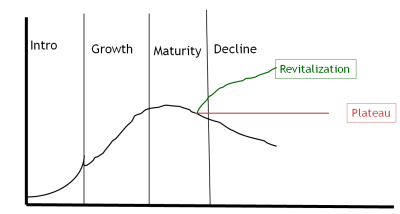
Consumers know McDonald’s for its French fries. However, the product had been on the decline stage and was no longer generating significant revenue (Perner, 2008). Consequently, McDonald’s reacted by revitalizing and repositioning it through a new product known as Shake Shake Fries. In addition, the company added new varieties to it, such as spices mix. This approach ensured that French fries remained relevant in its menu for revenue growth.
Although McDonald’s has several outlets and franchises, it strives to maintain the same quality and tastes of its products across the globe. McDonald’s can claim that all its products will be of the same quality and service always across the globe. The leading fast food company has demonstrated this over a number of years.
Consequently, customers can trust McDonald’s brands. This allows consumers to know what to expect from McDonald’s products and services whenever they make purchases. This flexibility allows consumers to trust McDonald’s to provide the same quality fast food in every outlet and franchise.
McDonald’s pricing tends to consider all elements of the marketing mix. The company provides value pricing whereby its offers products as low as $ 1. This combination provides quality products at fair prices to all customers. Therefore, a non-pricing approach is impossible for McDonald’s, even if it is the company leading in the fast food industry (Perner, 2008). Pricing strategy and implementation are necessary due to the competitive nature of the fast food industry.
In addition, McDonald’s must set a pricing strategy to cater to reduced costs that affect the price, promotion, and distribution of its products. These will strongly affect its pricing strategy. In all these marketing mixes oriented toward pricing, McDonald should know that consumers’ decision to buy goes beyond pricing alone as there are other factors that influence consumers’ decisions. Consumers seek the best values and satisfaction from their purchases.
McDonald’s sells to high-end consumers as well as low segments of its target markets. Consequently, McDonald’s pricing mix and implementation are necessary for determining the company’s success. McDonald’s value pricing strategy sends a message to all consumers of different segments and income statuses.
The advantage is that McDonald’s serves all segments of the market. Consumers need value for their spending, and McDonald’s has created this. McDonald’s pricing strategy must also account for competition. McDonald’s also experiences competition from other fast food companies. Therefore, a pricing strategy to outdo the competition and maintain the leading position, as well as market share, is crucial in McDonald’s marketing mix (Adcock and Halborg, 2004).
McDonald’s has noted customers’ sensitivity to prices. Consequently, the company has reacted by introducing low-cost, fast food of a dollar. However, some customers do not have to pay much attention to product pricing if they can get quality products and value. McDonald’s must use its pricing strategy and implementation as a tool for controlling other elements of the marketing mix.
McDonald’s has some of the most strategic places among fast food companies. The company seeks populated areas, places of high-end consumers, and easily accessible such as airports, busy streets, and retail stores. McDonald’s also likes locations near its main competitors, such as Subway and Burger King. This strategy is crucial to ensure that McDonald’s captures and supplies its products to all market segments.
McDonald’s is also available online as clients can place their orders. McDonald’s has a worldwide focus through its new outlets and franchise approach. Availability has enabled McDonald’s to remain competitive and conduct profitable business. Presence in such locations creates demands for such products. Place strategy has worked for McDonald’s as customers can easily access their favorite fast foods.
The choice of place also promotes McDonald’s brand image to its target markets. In addition, the choice of such places also influences the pricing of McDonald’s fast food products and the type of consumers who visit such places. Thus, McDonald’s serves both low-end consumers as well as high-end consumers who may not have time to prepare their meals (Gupta, 2010).
When implementing a place strategy, McDonald’s must consider the price, products, place, and people. McDonald’s must also watch its competitors, such as Subway and Burger King, as they choose their places. McDonald’s has been opening new outlets and franchises. McDonald’s place strategy must appeal to its employees, stakeholders, and customers.
Implementation of a promotional strategy is crucial for the success of any business venture. Companies rely on communication to promote their brand images and create awareness about their products. The company must consider the message and tools of communication in order to reach its target market.
McDonald’s has used several strategies, such as providing toys for kids, Big Mac Hockey Contest, and card games. Such strategies aim at promoting both its existing and new products. There are also advertisement campaigns that promote McDonald’s experience and active lifestyle.
McDonald’s uses channels such as television, newspapers, and radio. It also uses billboards and signage. The company also sponsors sporting events like Olympic Games and Little League. The company provides its branded drinks at such events. Lately, McDonald’s has used its Web site to promote its products. However, it is the television that has created the most memorable advertisement for the company.
McDonald’s has many slogans for different countries. Some of these slogans and advertisement campaigns have resulted in lawsuits.
McDonald’s also has a fifth element in the marketing mix that focuses on people. This is mainly to enhance customers’ experiences of McDonald’s products and services.
However, some reports indicate that McDonald’s tends to concentrate on children more than any other segment of the target markets in terms of advertisement budget and products alike (Story and French, 2004). According to John Koshuta, “the world’s largest fast food chain uses cartoons, toys, schools, charities, and even parents to reach its youngest customers” (Koshuta, 2007).
According to Advertising Age, McDonald’s spent $ 1.2 billion in the US alone in the year 2008. It is among the top 30 largest advertisers in the US. In the US, McDonald’s has a national and local advertisement strategy. The company has a national budget for national advertisements, and local co-operatives organize local advertisements. The industry total is $ 5.6 billion. Koshuta notes “about 40% of McDonald’s total advertising budget focuses on children” (Koshuta, 2007).
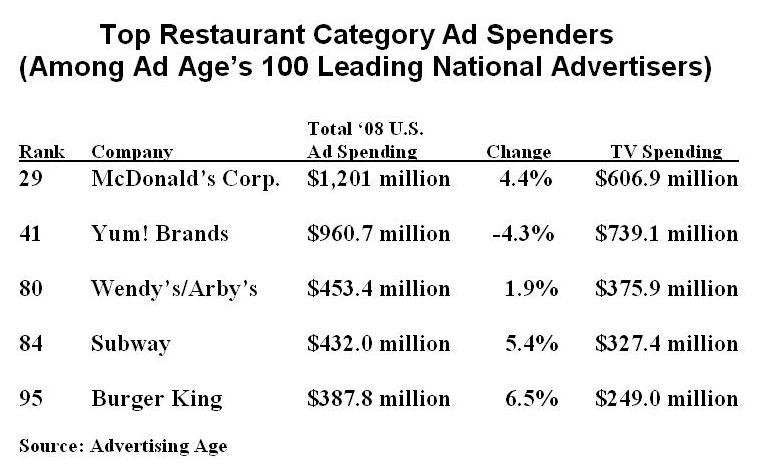
A marketing plan will provide McDonald’s with the road it requires in order to pursue its marketing objectives. However, a marketing plan is just a plan; thus, it is not a guarantee that the company will achieve such desired goals.
Therefore, turning a marketing plan into a strategy needs practical implementation. This will turn the plan into action and, in turn, helps achieve strategic marketing objectives (McDonald, 2007). Implementing any strategy requires resources. McDonald’s needs a strategy management approach that will ensure that the marketing plan becomes the center of focus (Lehmann, 2007).
The best marketing plan with the best strategic plan will ensure that McDonald’s achieves its business goals and objectives of Plan to Win . Some authors have argued that the implementation of the plan is more crucial than the strategy. However, implementation and strategy depend on each other for success.
Kotler and associates note that implementation results in a competitive advantage for the company (Kotler, Wong, Saunders, and Armstrong, 2005). In this context, scholars have identified three stages that are crucial for the implementation of business strategy. These include owning the plan, supporting the plan, and adapting the plan.
Most business plans fail due to a lack of ownership. McDonald’s management teams must demonstrate a willingness to support the plan. They can claim a stake in it and take responsibility during its formulation. Management must promote ownership of the plan by establishing action points, plan, involvement of senior level management, compensation, champions, and ownership team.
Senior-level management of McDonald’s must also actively participate in the process. They must remain committed and take part in the review of the progress of the plan. Senior-level management that shows less interest in the plan may communicate a lack of interest in the plan. Consequently, champions and ownership groups may feel a lack of interest too. This may result in a complete failure of the plan due to its lack of implementation (Aaker, 2009).
McDonald’s must also support the plan. Supporting the plan depends on five company elements. These include human resources with the necessary competencies and skills and leadership needed to implement the plan successfully. Allocation of resources such as time, personnel, and money will also affect the implementation of the plan. The organization must also provide the required structures in terms of policies and practices that guide a marketing plan.
The support for the plan also requires the organization to provide systems of information flow, operation, communications, rewards, planning, and measurement of outcomes. Lastly, organizational culture also influences the outcome of plan implementation. McDonald’s must have a strong culture that supports marketing initiatives and promote coordination during implementation processes. These five elements must be in line with each other and aligned with the business strategy of the organization (Baker, 2008).
Businesses have control systems that guide their strategic plans in order to adapt to dynamic market situations. A strategic marketing plan sets the direction and offers the company a direction for implementation and continuous improvement as it adapts to the market (Gilligan and Wilson, 2007).
Controls ensure that McDonald’s takes corrective measures after evaluating its marketing plan. This will ensure that the company achieves its strategic plan. McDonald’s must find ways to narrow boundaries due to its international presence by creating a cross-functional management system that communicates organizational plans across various units or countries (Aaker, 2009).
Aaker, D 2009, Strategic Market Management, 9th edn, Wiley, New York.
Adcock, D and Halborg, A 2004, Marketing Principles and Practice, 4th edn, Prentice Hall, London.
Baker, M 2008, Marketing Strategy and Management, Palgrave, London.
Bateman, S and Snell, A 2004, Management: The new competitive landscape, 2nd edn, McGraw-Hill, New York, NY.
Ferrel, C and Hartline, M 2005, Marketing Strategy, Thompson South-Western, Mason, Ohio.
Gilligan, C and Wilson, R 2007, Strategic Marketing Management: planning, implementation and control, 3rd edn, Butterworth-Heinemann, London.
Gupta, A 2010, Marketing: Competitor Analysis of McDonald’s . Web.
Hooley, G, Saunders, J, Piercy, N and Nicoulaud, B. 2007. Marketing Strategy and Competitive Positioning, 4th edn, South-Western College Pub, London.
Jobber, D 2010, Principles and Practice of Marketing, 6th edn, McGraw-hill, London.
Koshuta, J 2007, ‘McDonald’s Marketing Focused On Children’, Organic Consumer Association, vol. 12 no. 7, pp. 1-2.
Kotler, P, Wong, V, Saunders, J and Armstrong, G. 2005. Principles of Marketing, 4th edn, Pearson Education Limited, Essex.
Lehmann, D 2007, Analysis for Marketing Planning, McGraw-Hill/Irwin, London.
McDonald, M 2007, Marketing plans: how to prepare them, how to use them, Butterworth Heinemann, Oxford.
McDonald’s Corporation 2010, McDonald’s Corporation: 2010 Annual Report. McDonald’s Corporation, Oak Brook, IL.
Perner, L 2008, The Marketing Mix: Product . Web.
Story, M and French, S 2004, ‘Food Advertising and Marketing Directed at Children and Adolescents in the US,’ International Journal of Behavioral Nutrition and Physical Activity, vol. 1, no. 3, pp. 1-3.
WSJ 2008, ‘New Wendy’s to target older customers,’ Wall Street Journal, vol. 30, pp. 1-1.
- Chicago (A-D)
- Chicago (N-B)
IvyPanda. (2019, May 15). McDonald's Marketing Plan and Strategy Report. https://ivypanda.com/essays/marketing-plan-for-mcdonalds-corporation-report/
"McDonald's Marketing Plan and Strategy Report." IvyPanda , 15 May 2019, ivypanda.com/essays/marketing-plan-for-mcdonalds-corporation-report/.
IvyPanda . (2019) 'McDonald's Marketing Plan and Strategy Report'. 15 May.
IvyPanda . 2019. "McDonald's Marketing Plan and Strategy Report." May 15, 2019. https://ivypanda.com/essays/marketing-plan-for-mcdonalds-corporation-report/.
1. IvyPanda . "McDonald's Marketing Plan and Strategy Report." May 15, 2019. https://ivypanda.com/essays/marketing-plan-for-mcdonalds-corporation-report/.
Bibliography
IvyPanda . "McDonald's Marketing Plan and Strategy Report." May 15, 2019. https://ivypanda.com/essays/marketing-plan-for-mcdonalds-corporation-report/.
- McDonald's Franchise Model
- McDonald's History of Conquest
- McDonald’s New Strategy Toward Healthy Food
- Marketing plan - Arimount Company
- The Starbucks’ Growth and Its Competitive Environment
- Marketing Plan for the School of International Business
- Marketing Strategies of Major Car Manufacturers in Emerging Markets
- A Research on Store Loyalty Card
- Today's news
- Reviews and deals
- Climate change
- 2024 election
- Fall allergies
- Health news
- Mental health
- Sexual health
- Family health
- So mini ways
- Unapologetically
- Buying guides
Entertainment
- How to Watch
- My Portfolio
- Latest News
- Stock Market
- Premium News
- Biden Economy
- EV Deep Dive
- Stocks: Most Actives
- Stocks: Gainers
- Stocks: Losers
- Trending Tickers
- World Indices
- US Treasury Bonds
- Top Mutual Funds
- Highest Open Interest
- Highest Implied Volatility
- Stock Comparison
- Advanced Charts
- Currency Converter
- Basic Materials
- Communication Services
- Consumer Cyclical
- Consumer Defensive
- Financial Services
- Industrials
- Real Estate
- Mutual Funds
- Credit cards
- Balance Transfer Cards
- Cash-back Cards
- Rewards Cards
- Travel Cards
- Personal Loans
- Student Loans
- Car Insurance
- Morning Brief
- Market Domination
- Market Domination Overtime
- Opening Bid
- Stocks in Translation
- Lead This Way
- Good Buy or Goodbye?
- Fantasy football
- Pro Pick 'Em
- College Pick 'Em
- Fantasy baseball
- Fantasy hockey
- Fantasy basketball
- Download the app
- Daily fantasy
- Scores and schedules
- GameChannel
- World Baseball Classic
- Premier League
- CONCACAF League
- Champions League
- Motorsports
- Horse racing
- Newsletters
New on Yahoo
- Privacy Dashboard
Yahoo Finance
Decoding mcdonald's corp (mcd): a strategic swot insight.
McDonald's Corp showcases robust financial growth with a 4.6% increase in total revenues.
Net income rises to $1,929 million, marking a 7% improvement over the previous year.
Strategic franchising and global brand strength continue to drive McDonald's success.
Investments in digital innovation and global expansion underscore future growth opportunities.
Warning! GuruFocus has detected 3 Warning Sign with MCD.
On May 8, 2024, McDonald's Corp ( NYSE:MCD ) released its 10-Q filing, revealing a comprehensive financial performance for the first quarter of the year. The company, known for its global dominance in the fast-food industry, reported a notable increase in total revenues from $5,898 million in 2023 to $6,169 million in 2024, a 4.6% year-over-year growth. This financial upswing is further evidenced by a 7% rise in net income, climbing from $1,802 million to $1,929 million. The earnings per share (EPS) also saw an uptick, with basic EPS rising from $2.47 to $2.67 and diluted EPS from $2.45 to $2.66. These figures underscore McDonald's Corp's financial resilience and its ability to maintain profitability amidst a dynamic market landscape.
Global Brand and Market Presence: McDonald's Corp ( NYSE:MCD ) continues to leverage its iconic brand, which is synonymous with fast-food across the globe. The company's brand strength is a critical asset, contributing to its $130 billion in system sales across nearly 42,000 stores. The brand's widespread recognition facilitates customer loyalty and consistent traffic, a testament to its enduring appeal and marketing prowess. McDonald's strategic marketing initiatives, such as "Feel-Good Marketing," resonate with customers worldwide, reinforcing the brand's relevance and emotional connection.
Franchising Model Efficiency: McDonald's Corp's franchising model is a cornerstone of its financial strength. Approximately 60% of its revenue stems from franchise royalty fees and lease payments, a testament to the model's success. This structure not only minimizes operational risks but also ensures a stable and predictable revenue stream. The company's strategic co-investments with franchisees in restaurant improvements and operating systems further enhance the brand's value and drive performance across the franchise network.
Dependence on Franchisees: While McDonald's Corp's franchising model is a strength, it also presents a vulnerability. The company's performance is heavily reliant on its franchisees' success, which can be influenced by various factors beyond corporate control, such as local market conditions and management effectiveness. Any misalignment or inconsistency in operations among franchisees could potentially tarnish the brand's reputation and impact overall performance.
Market Saturation Risks: McDonald's Corp operates in a highly competitive and mature market, where growth opportunities may be limited by market saturation. As the company seeks to expand its global footprint, it may encounter challenges in finding new markets or increasing market share in existing ones without cannibalizing sales from current locations. This saturation also intensifies competition, putting pressure on McDonald's to continuously innovate and differentiate its offerings to maintain its market position.
Opportunities
Digital Innovation and Customer Engagement: McDonald's Corp has identified digital innovation as a key driver for future growth. The company's investments in digital platforms, including mobile ordering, loyalty programs, and personalized marketing, are designed to enhance customer engagement and convenience. By expanding its digital capabilities, McDonald's aims to attract a younger demographic and create a more seamless customer experience, which could lead to increased sales and customer loyalty.
Global Expansion and New Markets: Despite the challenges of market saturation, McDonald's Corp sees significant growth potential in international markets. The company's plans to open more than 2,100 new restaurants in 2024 reflect its ambition to tap into emerging markets and capitalize on global urbanization trends. By strategically entering new territories and optimizing its restaurant footprint, McDonald's can continue to expand its global presence and drive systemwide sales growth.
Macroeconomic and Geopolitical Uncertainties: McDonald's Corp operates in a complex global environment where macroeconomic and geopolitical factors can significantly impact its business. Fluctuations in currency exchange rates, trade policies, and political instability in key markets can affect the company's profitability and operational efficiency. The ongoing war in the Middle East, for instance, has already had a slight negative impact on the International Developmental Licensed Markets segment's comparable sales.
Changing Consumer Preferences and Health Trends: As consumer preferences evolve, particularly towards healthier and more sustainable options, McDonald's Corp must adapt its menu offerings to stay relevant. The fast-food industry faces increasing scrutiny over nutritional content, sourcing practices, and environmental impact. McDonald's needs to continuously innovate its menu and supply chain practices to meet these changing demands and mitigate the risk of losing market share to competitors who may be quicker to respond to such trends.
In conclusion, McDonald's Corp ( NYSE:MCD ) demonstrates a strong financial and strategic position in its latest SEC 10-Q filing. The company's robust brand, efficient franchising model, and strategic investments in digital innovation position it well for continued success. However, reliance on franchisees, market saturation, macroeconomic uncertainties, and evolving consumer preferences present ongoing challenges. By leveraging its strengths and addressing its weaknesses, McDonald's can capitalize on opportunities and navigate threats, ensuring its place as a leader in the global fast-food industry.
This article, generated by GuruFocus, is designed to provide general insights and is not tailored financial advice. Our commentary is rooted in historical data and analyst projections, utilizing an impartial methodology, and is not intended to serve as specific investment guidance. It does not formulate a recommendation to purchase or divest any stock and does not consider individual investment objectives or financial circumstances. Our objective is to deliver long-term, fundamental data-driven analysis. Be aware that our analysis might not incorporate the most recent, price-sensitive company announcements or qualitative information. GuruFocus holds no position in the stocks mentioned herein.
This article first appeared on GuruFocus .
McDonald's eyes record global expansion in coming years, with more focus on delivery
Burger giant aims to add thousands of new locations around the globe by 2027.

Social Sharing
McDonald's is expecting to go through a growth spurt.
The Chicago-based burger giant wants to establish thousands of new locations around the globe in the next few years, aiming to have 50,000 locations operating by 2027.
That's up roughly 25 per cent from more than 40,000 McDonald's locations in operation today. The company says its anticipated expansion would represent the chain's fastest-ever period of growth.
A super-sized footprint isn't the only way the fast-food chain intends to grow its business, though — as McDonald's intends to use a combination of technology and a greater focus on its delivery capabilities to better serve customers in the years ahead.
More stores in Canada?
Canada, which is already home to more than 1,400 McDonald's restaurants , will be among the markets to see new stores in the proposed expansion effort, according to The Associated Press .
The company declined to share details on its Canadian expansion plans, but it pointed to recent comments to investors by Jill McDonald, president of the chain's wholly owned international operated markets .
"Canada is one of my top markets," she recently told investors. "Looking at the shift in some of the population that's going on, we definitely see significant opportunities for growth in Canada, across the country."

McDonald's is also aiming to open 900 new stores in the United States and another 1,900 in international markets where company-operated and franchised restaurants are located — including in Canada, Australia, Germany and the United Kingdom.
Anil Verma, a professor emeritus of industrial relations and human resources management at the University of Toronto's Rotman School of Management, said finding enough people to serve Canadian customers likely won't be an issue for the fast-food giant, especially in the near term.
"For the next five years ... Canada will have a steady supply of immigrant labour," Verma said in a phone interview with CBC News.
- George Cohon, founder of McDonald's Canada who brought Big Mac to Soviet Union, dead at 86
- Why McDonald's menu items are different prices, even in the same city
Some of the next wave of Canada's newest workers will be looking for this type of employment, he said.
McDonald's also plans on establishing some 7,000 new locations in what it calls international developmental licensed markets, which are operated by licensees. More than half of them will be established in China, according to CFO Ian Borden.
Verma said there's ample labour available for McDonald's in emerging economies such as India and Brazil, both of which are part of the same group of international markets.
More focus on delivery
Delivery is an increasingly important aspect of the company's business, with global sales exceeding $16 billion US, up from $1 billion just six years ago.
That's prompting the company to put more focus on how its restaurant locations deliver.
Yann Cornil, an associate professor of marketing and behavioural science at the University of British Columbia's Sauder School of Business in Vancouver, said he sees demand for delivery as a strong and ongoing trend that McDonald's has picked up on.

"The pandemic has largely accelerated this trend, but it was already present before. We can see how much actors, like Uber Eats, Grubhub or Doordash have grown, as an illustration of the home delivery trend," Cornil said, when discussing the McDonald's expansion news via email.
"As a consequence, McDonald's is adapting its business model," Cornil said, adding that home delivery orders provide companies with substantial information about their customers, which can be harvested for business purposes.
Anthony Goerzen, the Sobey Professor of International Business at the Smith School of Business at Queen's University in Kingston, Ont., said McDonald's is recognizably skilled at finding the right place to put its restaurants so customers visit frequently.
- Goodbye to golden arches in Kazakhstan, as McDonald's exits market
- McDonald's will soon reopen its locations in Ukraine
He said he believes some McDonald's executives would actually view real estate as their main business, with hamburgers being "a byproduct."
"To escalate the delivery piece would suggest that food is becoming more important in their business model," he said via email.
"The challenge is to find these new locations that are friendlier to pick-up/delivery drivers given that any change to an established, successful strategy puts the firm back on the steeper part of the learning curve."

Yet McDonald's president and CEO Chris Kempczinski has signalled that the company is thinking of both dine-in and delivery-minded customers with the coming changes, which he said will also see new restaurants equipped with dedicated pickup areas for delivery drivers.
"Not everybody wants delivery every single meal. Sometimes they want to go to the restaurant with their family," Kempczinski told The Associated Press in an interview.
The CEO said he's not concerned about cannibalizing sales from existing McDonald's locations. In the U.S., he said, population shifts have left many parts of the country underserved. McDonald's also wants to prevent competitors from snatching up good real estate, he said.
More technology
In announcing its expansion plans, McDonald's also pointed to a "strategic partnership" it has established with Google , to apply various types of hardware and technology — including AI — to its business operations.
The University of Toronto's Verma said the company's embrace of technology will affect how many people it employs, how it operates its restaurants and the delivery side of its business.

Verma predicts automation and technology will mean a need for fewer workers at restaurants than is the case today — and that could limit the impact of labour costs, even if wages go up.
Within the broader labour market, Verma said, "we are on the cusp of a transformational change that we only see once in a generation," whereby the impact of new technology will have a "huge impact" on how business gets done — including in the fast food industry.
ABOUT THE AUTHOR

Geoff Nixon is a writer on the national digital desk in Toronto. He has covered a wealth of topics, from real estate to technology to world events.
With files from The Associated Press and Reuters
Related Stories
We use cookies to make interactions with Joorney easier and to improve communications.
By continuing to use this site, you agree to the use of cookies as described in our Privacy Policy.
- E-2 Visa Business Plan
- L-1 Visa Business Plan
- EB-2 NIW Visa Business Plan
- EB-5 Visa Business Plan
- Regional Center Business Plan
- Investor Business Plan
- Financial Model
- SBA/Bank Loan Business Plan
- Grant Business Plan
- Landlord Deck
- Pro Bono Business Plan
- Confidential Information Memo (CIM)
We’re here to help! Call now:
Want to better support your clients?
What clients and partners say about working with Joorney.
Learn about our purpose and vision for the future.
Joorney is the people and culture behind it.
Looking to make an impact? Explore open positions on the Joorney team.
We're always here for you.
Latest company updates and industry insights.
Upcoming Joorney special events, webinars, and conferences.
Answers to common questions about our services.
Learn from our experts.
Franchise Business Plan – McDonald’s
When writing a business plan for a McDonald’s franchise it is important to demonstrate the in-depth understanding of the franchise agreement as all McDonald’s restaurants must operate in line with the “McDonald’s System”, a concept of restaurant operations that includes, among others, rights in trademarks, manuals, and other confidential business information, and operational, real estate, and marketing information. According to IBISWorld , McDonald’s has 37,000 restaurants in over 100 countries, out of which more than 90% are operated by franchisees, the remainder being company-operated stores.
When drafting a business plan for a McDonald’s restaurant, there are several issues to address.
Initial Investment
Generally, no financing arrangements are offered by McDonald’s. The company allows franchisees to open a new restaurant or purchase an existing one. The cost of opening a new restaurant generally includes a $45,000 fee, a down payment of 40% of the total costs of a new restaurant, and the average equipment and pre-opening costs of $1,611,040. The cost of purchasing an existing restaurant includes the price of an existing restaurant which varies on a wide range of factors such as sales volume and profitability and a minimum of 25% cash down payment. Joorney Business Plans has experience in creating long-term financial projections for McDonald’s restaurants and understands the specifics pertaining to the initial investment requirements.
The company selects the site for the location of a restaurant and negotiates the location’s purchase or lease. The choice of location is based on a variety of factors such as population density, traffic patterns, and competition. However, as McDonald’s cannot guarantee that the economic and demographic factors at a specific restaurant location will remain constant, Joorney Business Plans develops in-depth local market analyses with the expected local economic and demographic trends.
Regulations
A McDonald’s restaurant is required to comply with various local, state, and federal laws, including health and sanitation laws and menu-labeling requirements. Joorney Business Plan Writers have experience helping McDonald’s franchisees create a timeline of activities, including obtaining licenses, with a particular focus on the initial year, as per requirements of the investors and immigration services.
All McDonald’s franchisees must complete a training program successfully before signing the franchise agreement. McDonald’s bears the cost of maintaining the Hamburger University and other training centers and provides instruction for the operation of a franchise restaurant. However, a franchisee must cover all traveling, living, and compensation expenses related to employee training. Joorney Business Plans has experience describing and developing employee plans and linking the proposed individuals’ knowledge and training to their designated roles.
If you are lucky enough to be selected as a McDonald’s franchisee, it is the opportunity of a lifetime. You get guaranteed return on investment due to their gigantic historical performance numbers and internationally recognized brand and not many franchises can compete with that.
Share this article
Stay informed
Latest Industry News & Insights
Our Plan for Change
- McDonalds.com
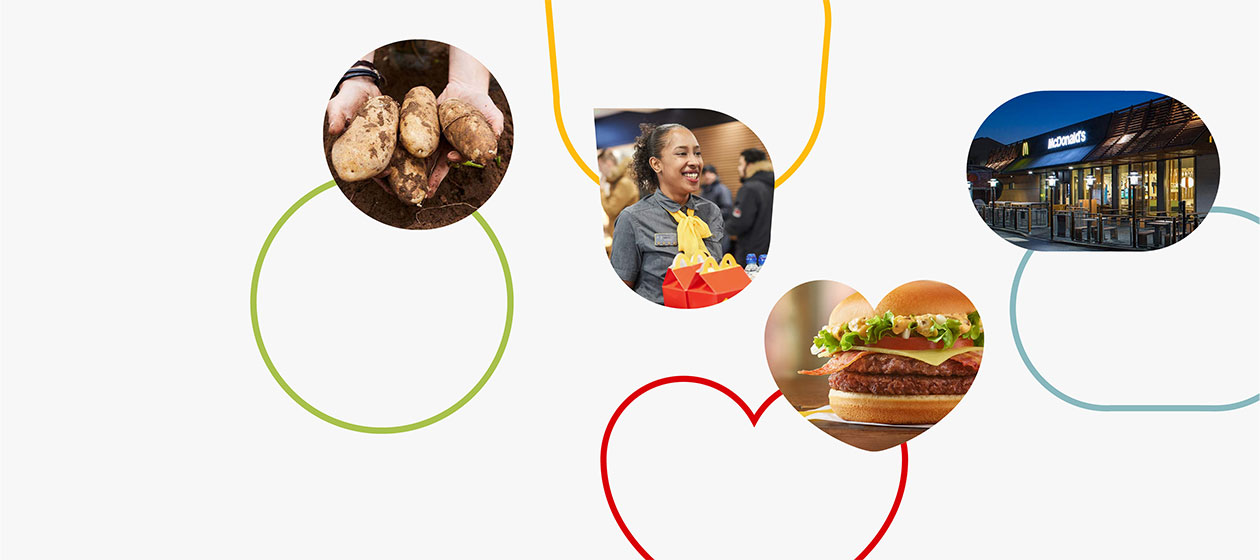
Our Plan for Change is a clear plan with goals and actions to help us lead positive change across our business and beyond.
Imagine the impact if around 1,400 restaurants, 130,000 crew, over 23,000 British and Irish farmers and 4 million daily customers change a little. Together we can change a lot.
We’ve been proudly serving communities across the UK and Ireland since 1974. But this moment in time requires us to accelerate our ambition – and work even harder to look after each other and our planet. That means not just keeping pace with change, but leading the change, and playing our part in bringing a more sustainable, fairer future within closer reach for everyone.
So, we’ve set ourselves a challenge to lead this change across four key areas, while continuing to serve our communities. Our aims include achieving net zero emissions across our entire business and value chain by 2040.

Planet Positive
Taking action on climate and nature
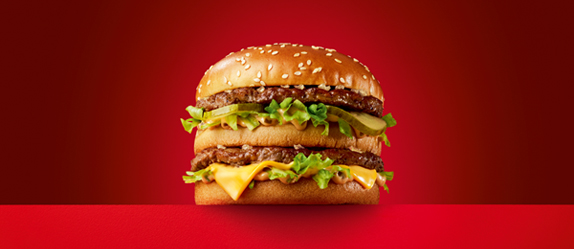
Working on sustainable sourcing and more balanced choices
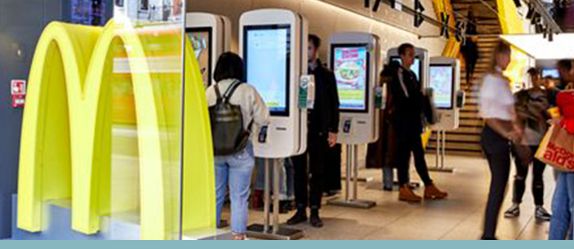
Great Restaurants
Net zero and closing the loop on waste

People Positive
Building skills, jobs and opportunities

Serving our Communities
Stepping up for families and young people
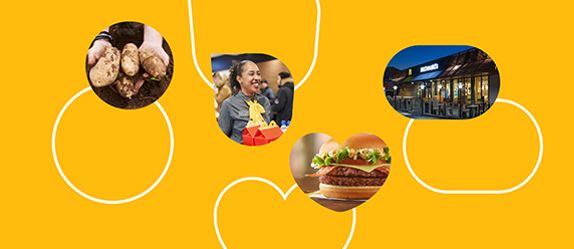
Our long-term goals in full
See the details behind our Plan
Leading the change
“It’s more vital than ever that we help lead positive change right across our business, from farms to front counter.
" Paul Pomroy", CEO UK & Ireland
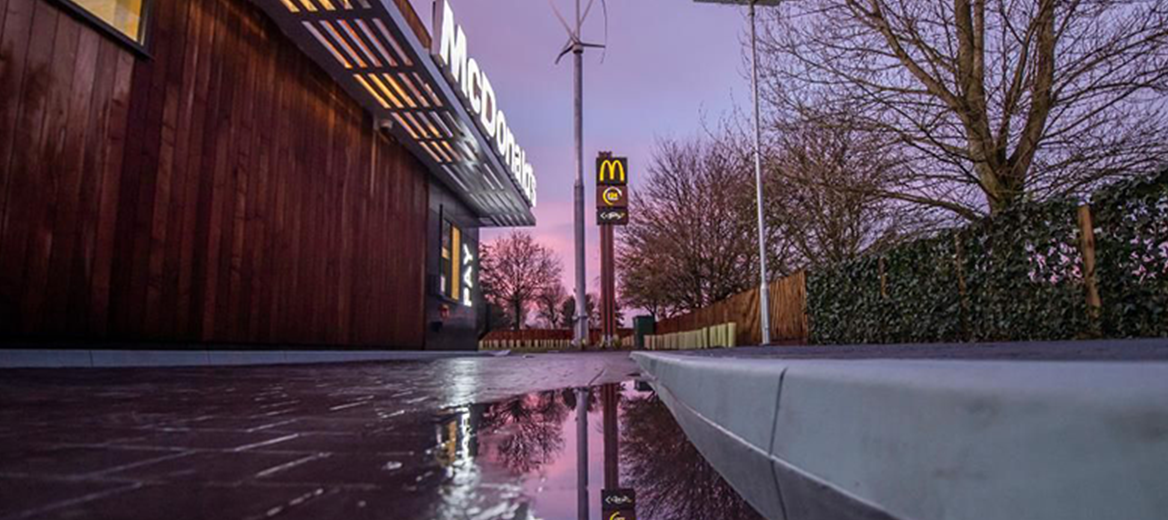
Building restaurants for the future
Find out more about the sustainable innovations built into our new UK industry net zero emissions standard restaurant.
How it all adds up
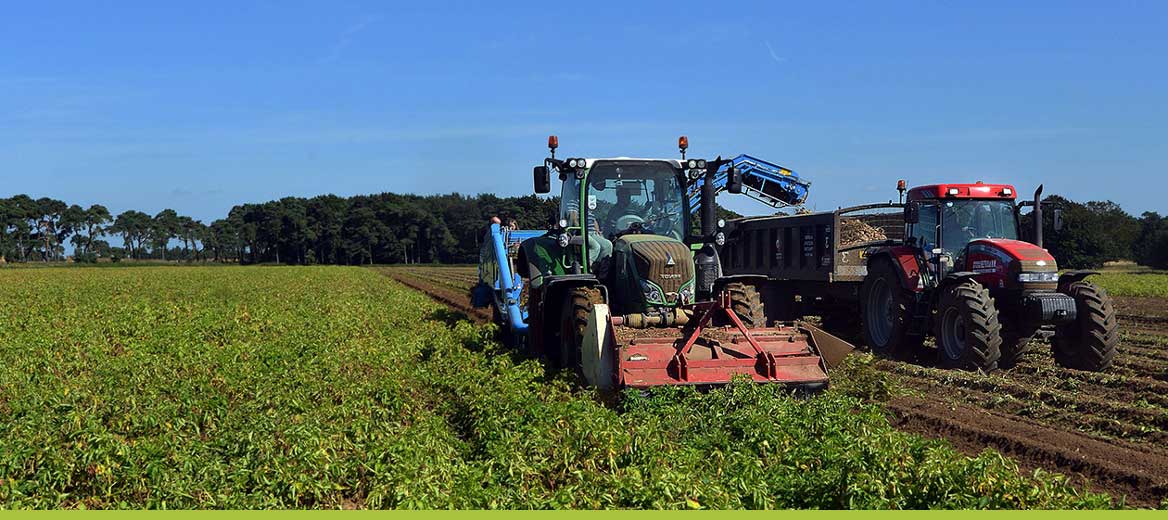
Setting out our roadmap for net zero emissions.
Working with British and Irish farmers to protect nature and livelihoods through our Farm Forward Programme .
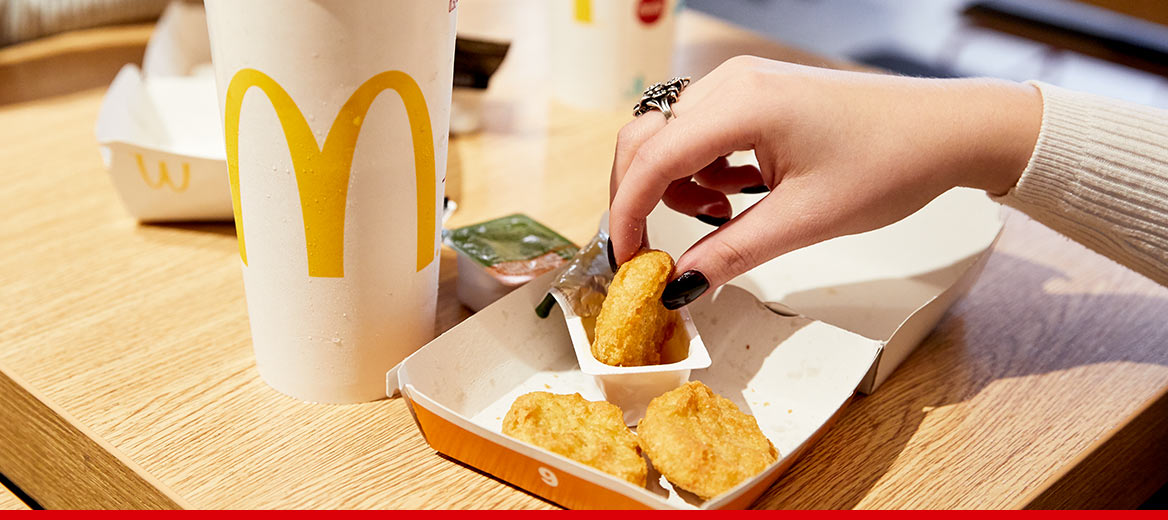
Developing a Plan for Change Scorecard to guide our ethical and sustainable sourcing decisions .
Launching our Nutrition Innovation Council to develop more balanced options that taste delicious .
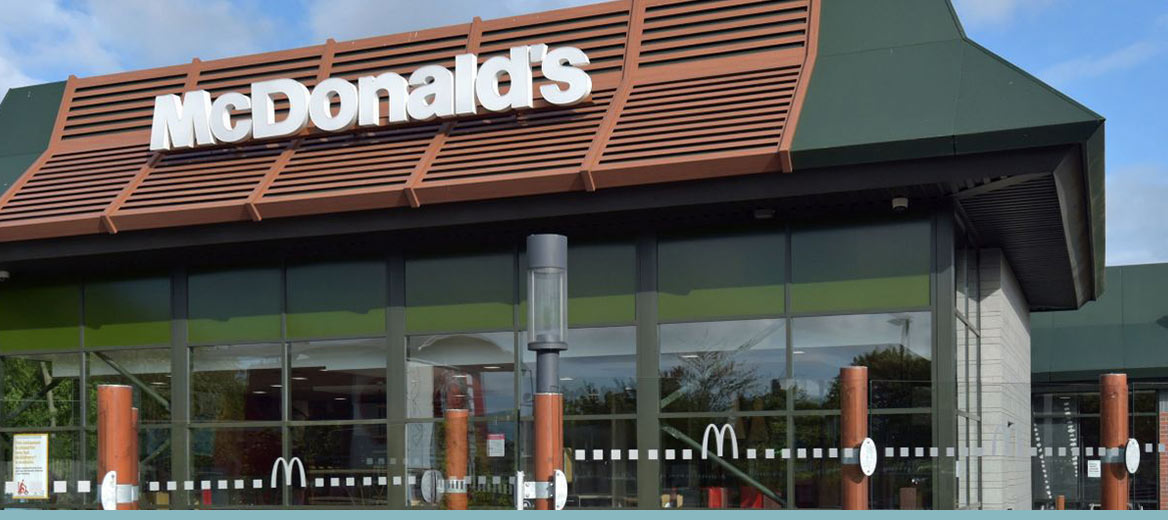
Creating a blueprint for UK industry net zero emissions standard restaurants
Transforming our packaging so waste becomes a thing of the past

Helping one million people gain new skills or jobs.
Championing underrepresented groups from restaurants to boardroom.

Serving Our Communities
Stepping up for families through Ronald McDonald House Charities ® (RMHC®) UK.
Partnering with Children in Need for better futures for young people.

Getting clear on climate
Find out how we’re helping farmers and customers get under the skin of sustainability with our two separate guides.
Order McDelivery® through our app to earn Rewards Points

McDonald’s Takes Economical Hit, Considering New Deal To Win Back Customers
McDonald's is considering coaxing customers back to its restaurants by offering a new food deal that won't take a hit on your wallet.
Inflation across the country is a struggle for many, including businesses. One of the most popular fast food chains worldwide is taking a hit, bringing in less profit than last quarter. So how are they going to bounce back? The company has a plan.
McDonald's Takes Economic Hit
Rising costs are affecting wallets across the United States, resulting in Americans cutting back on fast food. This comes as major chains, like McDonald's, have raised prices to offset increased labor and product expenses.
As of March 2024, McDonald's had a profit of $6.17B, which is down from its December 2023 profit of $6.41B. In September 2023, they brought in $6.69B.
As profit continues to decrease, the brand is trying to find ways to attract customers back. Leaders at McDonald's corporate offices are currently in talks with franchise owners to launch a new budget meal. This comes after McDonald's executives reported a decrease in the number of customers dining in at its restaurants.
McDonald's Could Launch A New $5 Meal
According to CBS News , McDonald's is considering adding a $5 meal option to its menus across the U.S. to help drive consumers back into its establishments.
If franchise owners agree, the meal would include a choice of either a McChicken, a McDouble, or four-piece chicken nuggets as its main dish, as well as fries and a drink.
At the April 30 earnings call, McDonald's CEO Chris Kempczinski said, "Consumers continue to be even more discriminating with every dollar that they spend as they face elevated prices in their day-to-day spending, which is putting pressure on the industry."
"It's imperative that we continue to keep affordability at the forefront for our customers," he added.
McDonald's Increases Prices
According to CBS, the finance website FinanceBuzz reports, "about 25% of people who make under $50,000 are cutting back on fast food, pointing to cost as a concern, a January poll by consulting firm Revenue Management Solutions found."
The report also finds that McDonald's is the business that raised its menu prices the most between 2014 and 2024.
"When you look at McDonald's, they're not getting a majority of high-income customers — the middle- and lower-income class are the bulk of their business," analyst and president of Kalinowski Equity Research Mark Kalinowski told CBS MoneyWatch. "They need to be cautious with their spending, and that's what you're seeing right now."
Americans Only Get Fast Food As A 'Rare Treat'
Soaring prices at fast-food chains like McDonald's and Taco Bell seem to be taking a bite out of sales. Recent earnings reports show a decline in same-store sales over the past year.
"The whole conceit was that you were getting some OK-level of food for a low price and you could get it quick," Kevin Roberts told CBS News . "Now I can't justify the expense. If I'm paying $15 for a burger and fry and drink and it's McDonald's quality, forget about it — I'm going home."
The 38-year-old told the outlet that he remembers when he could get a bacon cheeseburger, fries, and a drink from Five Guys for $10. Now, the bacon cheeseburger alone costs over $10. In Columbus, Ohio, it costs $12.99 for a bacon cheeseburger. It costs $13.09 in New York City and $14.39 in Los Angeles.
Now, he only gets fast food "as a rare treat."
"Nothing has made me cook at home more than fast-food prices," he told the news outlet.
Fast Food Prices Rise Across The United States
McDonald's isn't the only fast food chain to increase prices as FinanceBuzz reports that, between 2014 and 2024, Popeye's, Jimmy John's, and Subway's food prices climbed 86%, 62%, and 39%, respectively.
The finance website states that the price of a two-piece chicken combo at Popeyes went from $6.49 to $11.39, and Jimmy John's eight-inch club tuna jumped from $5.75 to $9.10.
This is due to minimum wages increase across the United States. Per CBS, "Across the U.S., 22 states raised their minimum wages in January, although the federal baseline pay remains stuck at $7.25 an hour. In California, fast-food chains with 60 or more locations nationwide are now required to pay their workers a minimum wage of $20 an hour following passage of a new law last fall."

- The Inventory
Support Quartz
Fund next-gen business journalism with $10 a month
Free Newsletters
McDonald's hopes a $5 Meal Deal will win back inflation-weary customers
But putting the plan into action will depend on whether franchisees get on board.
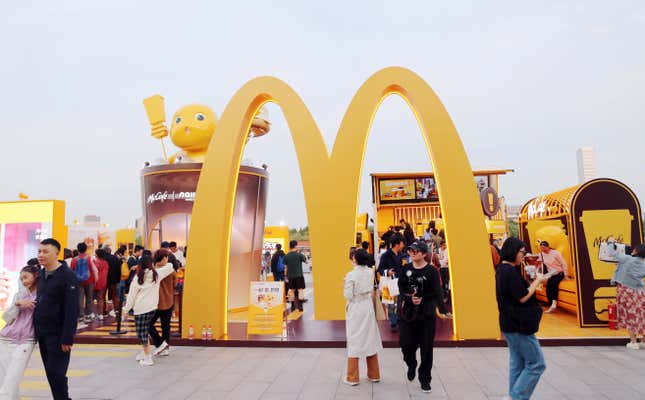
McDonald’s wants to introduce a $5 meal deal in an effort to win over cash-strapped consumers .
Related Content
Bloomberg, citing anonymous sources with knowledge of the situation, reported that the bundle may consist of a McChicken or a McDouble with fries and a drink.
That strategy, however, may be difficult for the fast food chain to put into place, at least in the U.S., in part because McDonald’s relies tremendously on a franchised business model. About 93% of its restaurants are operated by franchisees.
It isn’t the first time the company has attempted to launch the $5 deal, according to the unnamed sources, who told the publication the chain fell short of getting approval after some franchisees said they worried they would lose cash on the initiative.
In March, the company said it would make its burgers bigger , up its chicken supply, and refine its coffee experience, all in a bid to get consumers back.
In states like California, where a new law introduced in April raised the minimum wage to $20 an hour, chains like McDonald’s are struggling to keep prices low .
McDonald’s value proposition also comes at a time when the chain, and other food giants, are dealing with high inflation and waning consumer demand .
But that hasn’t kept McDonald’s from pushing its value plan idea into international markets , according to CEO Chris Kempczinski.
“What we don’t have in the U.S. right now is a national value platform at the same time that our competitors are out there with the national value platform,” said Kempczinski during the company’s first quarter earnings call last month.
“So the opportunity for us in the U.S., I think, is to get more aligned as a system around a strong national value proposition, that we can then use our media scale to drive high consumer awareness on it,” he added.
McDonald’s did not respond to a request for comment.
📬 Sign up for the Daily Brief
Our free, fast, and fun briefing on the global economy, delivered every weekday morning.
McDonald's $5 meal deal: More details reported in plan to lure customers
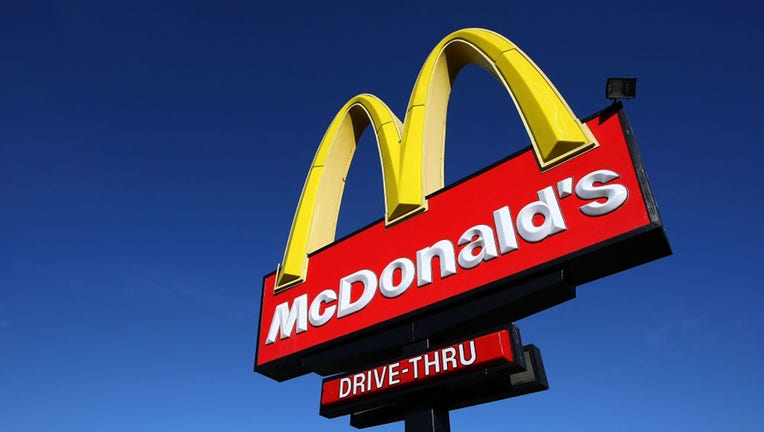
FILE - A sign stands outside of a McDonalds restaurant February 9, 2009, in San Francisco, California. (Photo by Justin Sullivan/Getty Images)
CHICAGO - McDonald’s is launching a new $5 meal deal promotion in the U.S. to help lure in customers deterred by rising fast food prices.
The restaurant chain’s new deal is scheduled to begin on June 25 and will last only about a month, according to the Wall Street Journal , citing internal emails. The $5 meal will include a McChicken or McDouble, four-piece chicken nuggets, fries and a choice of drink.
Bloomberg first reported last week that McDonald’s was planning to launch such a promotion , which required approval from franchise owners. Fast food restaurants have seen sales dip due to inflation driving more customers to eat at home.
McDonald’s did not specifically confirm the $5 deal, but in an email to FOX Television Stations, it noted the importance of "meaningful value" for its customers.
"We know how much it means to our customers when McDonald’s offers meaningful value and communicates it through national advertising," McDonald’s USA said. "That’s been true since our very beginning and never more important than it is today."
The company also shared a statement from John Palmaccio, a McDonald’s franchise owner/operator and Operators National Advertising (OPNAD) fund chair, who noted that "great value and affordability have always been a hallmark of McDonald’s brand, and all three legs of the stool are coming together to deliver that at a time when our customers really need it."
Los Angeles McDonalds looted on video
A McDonald's in Los Angeles, CA was looted by a group of people on Juneteenth. The video circulating online shows a group acting violently before it makes its way behind the counter to steal the cash register. More LiveNOW from FOX streaming video
Currently, a McChicken sandwich, featuring a breaded chicken patty, shredded lettuce, and mayonnaise, costs $5.59 at a McDonald's in Times Square, according to the New York Post .
McDonald’s works to combat slower fast food traffic
The new $5 meal deal is part of an overall effort by McDonald’s to step up deals and value messaging to combat the slowing sales.
In April, the burger giant said inflation-weary customers were eating out less often in many big markets. In the first quarter, fast food traffic was flat or down in the U.S., Australia, Canada, Japan, the United Kingdom and Germany.
"The consumer is certainly being very discriminating in how they spend their dollar," McDonald’s President and CEO Chris Kempczinski said during a conference call on April 30 with investors. "It may be more pronounced with lower-income consumers, but it's important to recognize that all income cohorts are seeking value."
McDonald’s said its same-store sales – or sales at stores open at least a year -- rose 1.9% worldwide in the January-March period. That was below Wall Street’s forecast of a 2.1% increase, according to analysts polled by FactSet.
Kempczinski checked his McDonald’s app during the call and noted that there were multiple deals available in his area, including one Big Mac for 29 cents when you buy another. And Kempczinski said 90% of U.S. restaurants are offering meal bundles for $4 or less.
But Kempczinski said McDonald’s needs a nationwide value message and marketing to back it up. In some areas, it’s losing out to competitors on customers’ perception of value and affordability, he said – noting how Wendy’s is currently offering free fries with the purchase of a medium burger.
"There’s a lot of great value out there, but everyone else has a value message too," Kempczinski said.
This story was reported from Cincinnati. The Associated Press contributed.
The $5 McDonald's meal is making a grand comeback in June — but only for a month
- McDonald's plans to launch a limited-time $5 meal.
- In first-quarter earnings, the company's leadership highlighted how inflation has affected customers.
- Other fast food chains are also worried about affordability.

McDonald's is looking to launch a $5 meal in the US in a move to bring back price-sensitive customers .
The meal includes four items, people familiar with the matter told Bloomberg and Restaurant Business . Customers would choose between two of the chain's signature burgers — a McChicken or a McDouble — and get four-piece McNuggets, fries , and a drink. The $5 promotion would last for a month, Bloomberg reported.
The deal will start on June 25, The Wall Street Journal and other outlets reported.
The discussions about the new deal come three weeks after the fast food giant's first-quarter earnings call, where leadership highlighted how customers are increasingly price-sensitive.
"I think affordability is clearly an area where consumer expectations are heightened," McDonald's chief financial officer Ian Borden said on the call. "Obviously, they're getting hit ," by inflation, he added.
The company previewed a value meal on the earnings call without any specifics. CEO Chris Kempczinski said McDonald's has local value meals around the US, but no standard national offering like competitors do.
Related stories
A $5 meal would be a stark drop from current prices, especially in higher-cost cities, according to a Business Insider analysis.
A meal consisting of the same four items — a McChicken, fries, a drink, and four-piece chicken nuggets — costs $18.26 in downtown New York City. In downtown San Francisco, the McChicken version costs $16.15, and the burger variant costs $17.75.
The new bundle would be priced lower than a Happy Meal, which starts at $6.39 in downtown Manhattan.
The company's stock has fallen about 7% year-to-date as investors worry about rising costs and intensifying fast-food competition.
Fast-food chains across the US are grappling with fewer orders from customers who no longer find their meals affordable. Wendy's, Shake Shack , Starbucks and Burger King parent Restaurant Brands International have all said in their latest earnings call that they will exercise caution on prices.
"We're going to stay careful on pricing," Gunther Plosch, Wendy's CFO, said in its earnings call earlier this month. "I don't think we're going to get too greedy."
Fast-food giants have also been hit by California's new minimum $20 hourly wage for limited-service restaurants. Franchisees that have raised prices are worried they may lose customers to sit-in dining chains like Chili's and Applebee's , which are not subject to the wage hike.
McDonald's did not respond to an immediate request for comment sent outside standard business hours.
Watch: US vs India McDonald's | Food Wars
- Main content
- Updated Terms of Use
- New Privacy Policy
- Your Privacy Choices
- Closed Captioning Policy
Quotes displayed in real-time or delayed by at least 15 minutes. Market data provided by Factset . Powered and implemented by FactSet Digital Solutions . Legal Statement .
This material may not be published, broadcast, rewritten, or redistributed. ©2024 FOX News Network, LLC. All rights reserved. FAQ - New Privacy Policy
McDonald's franchise group slams California fast-food law as 'draconian'
Ab 1228 recently received approval from the senate and is likely headed for gavin newsom's signature.

McDonald's is a resilient brand that thrives in any environment: Jim Skinner
Former McDonald's CEO Jim Skinner analyzes the state of the fast-food industry as the U.S. economy slows on 'The Claman Countdown.'
The National Owners Association called California’s recently-passed AB 1228 "draconian" and costly to franchisees in a memo distributed to its members.
"The new ‘AB 1228’ legislation has been voted into law and will result in a devastating financial blow to California McDonald’s franchisees at a projected annual cost of $250,000 per McDonald’s restaurant," the advocacy group representing some 1,000 McDonald’s franchisees said in the memo obtained by FOX Business.
"These costs simply cannot be absorbed by the current business model."
CNBC earlier reported on the NOA memo.
CALIFORNIA GOV. NEWSOM SIGNS LANDMARK FAST-FOOD WORKERS BILL, DESPITE CONCERNS IT WILL DRIVE UP COSTS
Among the bill's key components:
- It would raise the minimum wage for fast-food workers to $20 per hour.
- It would apply to restaurants with at least 60 locations nationwide, except for restaurants that make and sell their own bread.
- It would also create a 10-person council to govern fast-food chains, set guidelines for wages and make recommendations pertaining to working conditions.
When signing the original version of the legislation, California Gov. Gavin Newsom said, "California is committed to ensuring that the men and women who have helped build our world-class economy are able to share in the state’s prosperity. Today’s action gives hardworking fast-food workers a stronger voice and seat at the table to set fair wages and critical health and safety standards across the industry."

Gavin Newsom, governor of California, speaks during the United Nations Climate Action: Race to Zero and Resilience Forum in New York Sept. 21, 2022. (Michael Nagle/Bloomberg via Getty Images / Getty Images)
The state Senate passed AB 1228 Thursday.
The NOA said franchisees, suppliers and McDonald’s "must engage to support our California McFamily " and identified steps it said they each should take with ideas ranging from the franchisees establishing 501(c)4 entities and state political action committees (PACs) to create an official arm to lobby the government.
Suppliers urged the reduction of costs in operations that could lead to cost savings for fast-food restaurants they work with.
The NOA called on McDonald’s to direct "rent and service fees collected from sales" from potential price increases in response to the bill to efforts like "overhauling" the operational platform and doing more labor-related research and development to help franchisees.
In its memo, the NOA also made allegations about a "small coalition of franchisors" having "negotiated a deal with" the Service Employees International Union without franchisee involvement "causing the legislative outcome to now become certain." It mentioned McDonald’s, the National Restaurant Association and the International Franchise Association.
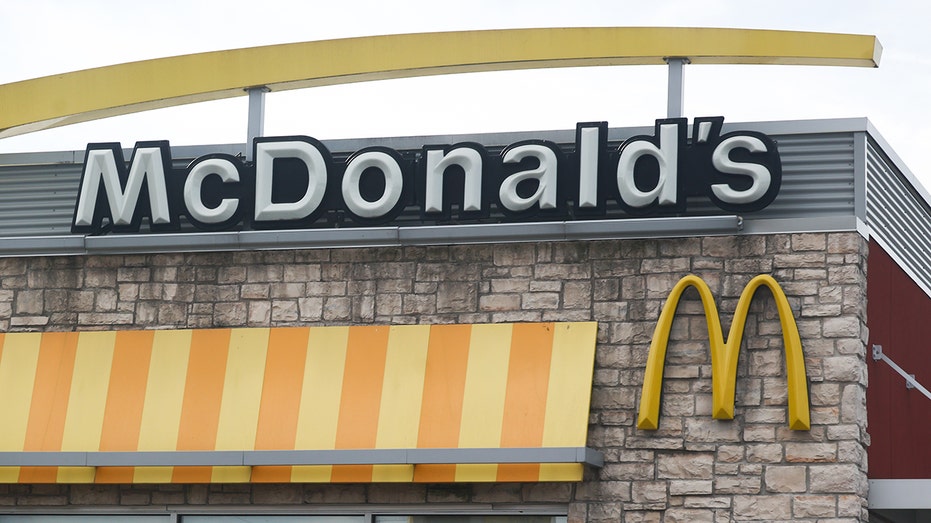
The McDonald's logo at a restaurant in Streator Oct. 15, 2022. (Jakub Porzycki/NurPhoto via Getty Images / Getty Images)
IFA CEO Matthew Haller told FOX Business he participated in the negotiations with a goal of making sure franchises had involvement and representation. Some franchisees spoke directly to the governor’s office, he added.
FOX Business also reached out to the National Restaurant Association for comment.
"Over the past year, I've worked closely with company leaders, a task force of fellow franchisees and our own independent advisers as part of a coalition of brands working to protect our business model against an all-out attack on restaurant owner/operators," California McDonald's franchisee Roger Delph said in a statement to FOX Business.
"Anyone who is suggesting this was not a collaborative and successful effort to protect the franchised business model in California, or that franchisee involvement was absent, was either not involved or is contorting the facts."
The NOA suggested AB 1228’s passage could lead to similar efforts by legislative bodies elsewhere in the country, adding, "We need to remain unified so that this can not gain a foothold anywhere else."
GET FOX BUSINESS ON THE GO BY CLICKING HERE
In a recent internal message obtained by FOX Business, McDonald's told its restaurant system AB 1228’s terms "are entirely different" compared to the prior version of the bill that it described as "harmful to our system."
McDonald's Corp
It said AB 1228 created a "significantly limited Fast Food Council," did away with AB 257, prevented joint liability from getting applied to franchisors and franchisees, and made a "clearer, predictable wage schedule through 2029," among other things.
McDonald’s "worked tirelessly" with the "California Owner/Operator Task Force" and others in the state to "protect owner/operators’ ability to make decisions for their businesses locally and protect their restaurants and their crew," the company said in the message.
CALIFORNIANS PUT FAST-FOOD LAW ON 2024 BALLOT
Those included the creation of a "coalition of brands to refer AB 257 to California voters in November 2024" and "significantly" increasing its "political engagement in the state," according to the message.
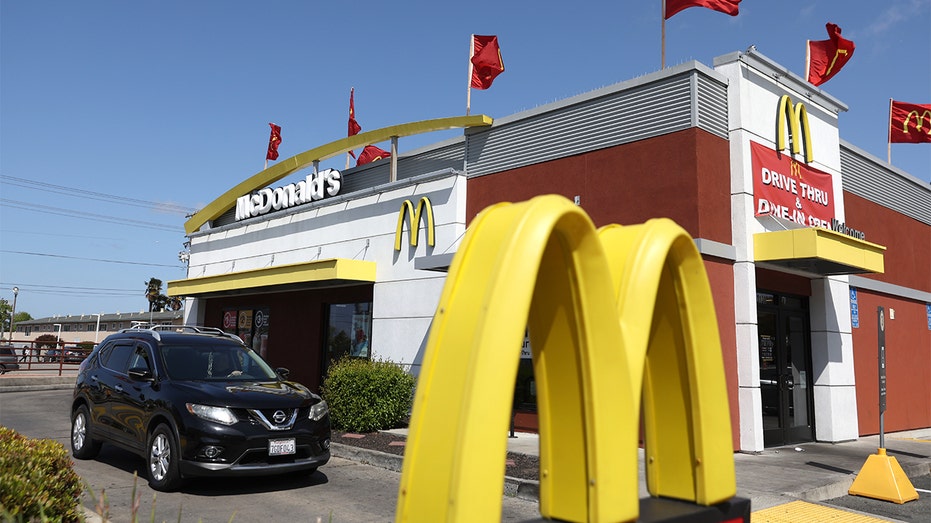
A sign is posted in front of a McDonald's restaurant April 28, 2022, in San Leandro, Calif. (Justin Sullivan/Getty Images / Getty Images)
The company said it has established a "cross-function, fast-action team of McDonald’s staff as well as Owner/Operators from California, New York and Illinois, to co-invest and work collaboratively on an action plan."
It will "pilot innovative short and long-term solutions" for California using best practices adapted from other places that have experienced similar legislation, according to the internal message.
Jay Caruso contributed to this report.
Correction: An earlier version of this story misstated the council's authority regarding working conditions. It can only make recommendations for those.
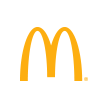
Our Approach & Progress

Reporting on Our Progress
This section of our website – Our Purpose & Impact – acts as the primary platform for our foundational approach, strategies and policies over each of our priority environmental and social issues, alongside recent progress highlights. In addition to our overall approach to issues, our goals and performance work in tandem to drive transformation across our four Impact Areas – the topics we know matter most to our stakeholders – helping us stay accountable for realizing our purpose and driving meaningful impact.
For a comprehensive view of our latest progress and actions against our goals, please see our 2022–2023 Purpose & Impact Report (PDF – 7 MB) or our Goal Performance & Reporting web page.
See All Current and Past Reports
Our Approach

Impact Strategy & Governance
Explore how we manage our impact strategy and govern our priority environmental and social issues.
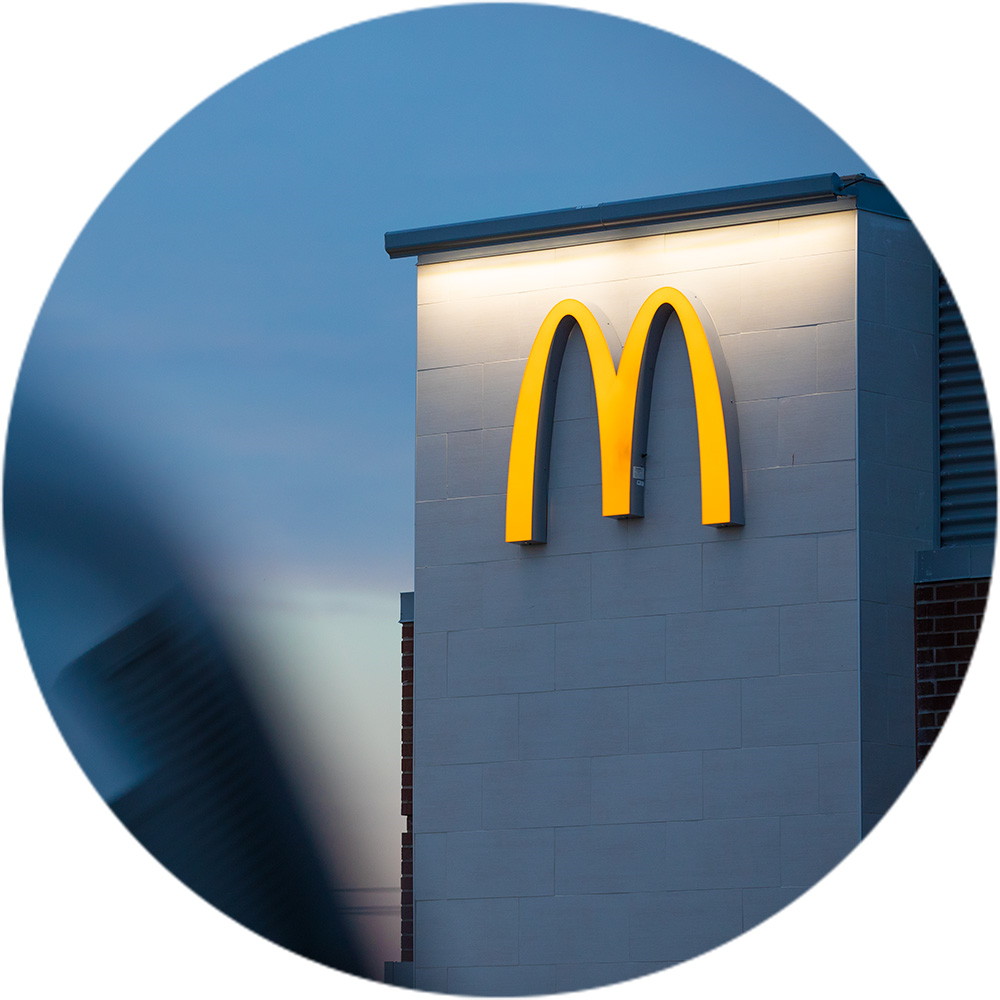
Stakeholder Engagement & Public Policy
Against the backdrop of a continually changing external landscape, we engage with key stakeholder groups on environmental and social issues where we believe McDonald’s can have the greatest impact.

Business Resilience
We are a trusted brand around the world, delivering on that trust every day by being resilient and agile in the face of challenging circumstances beyond our control.
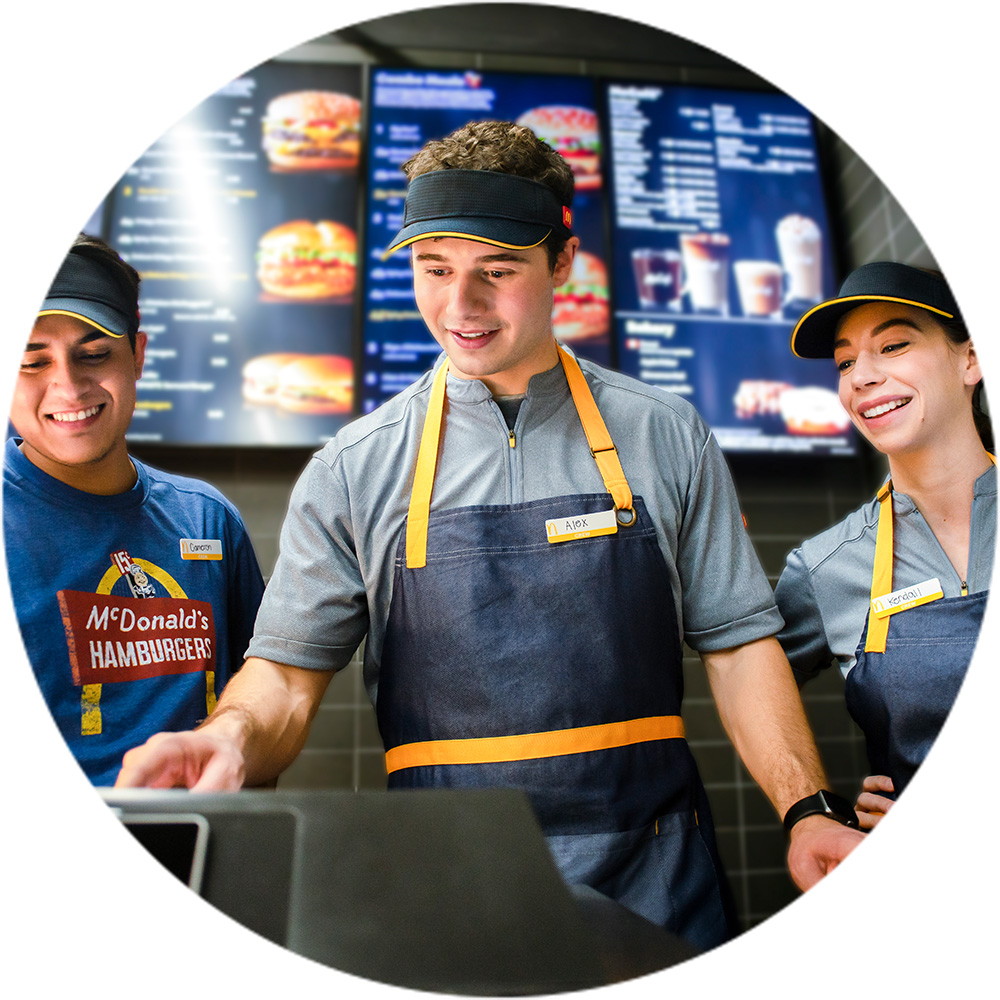
Contributing to the UN Sustainable Development Goals
Our work across each of our Impact Areas contributes important progress toward the multi-stakeholder agenda for sustainable development around the world.
Latest Stories
More in our purpose & impact.

Food Quality & Sourcing
We are working toward responsibly sourcing our priority commodities, prioritizing animal health and welfare and making safe, quality food accessible to families across the world.

We’re helping to drive climate action, protecting natural resources, reducing waste and transitioning to more sustainable packaging and toys.

Community Connection
Supporting people when and where they need it most.

Jobs, Inclusion & Empowerment
We’re serving up bright futures in our communities, nurturing skills, accelerating equity and respecting human rights.

IMAGES
VIDEO
COMMENTS
A brief history of McDonald's: Launched in 1948, Speedee Service System was the forerunner of McDonald's. It was launched by the two McDonald's brothers, who adopted the drive-in and franchising concept for fast-food delivery. Their first franchise agent was Ray Kroc, who opened the first McDonald's franchise back in 1955.He bought the rights to their business for US$ 2.7 million in ...
Introduction. Starting a fast-food empire like McDonald's requires careful planning and a solid business plan. In this comprehensive guide, we will walk you through the essential steps of creating a McDonald's business plan, covering market analysis, menu development, marketing strategies, operational structure, and financial projections.
McDonald's is a heavy-franchised business model. In 2022, over 60% of the total revenues came from franchised restaurants. The company's long-term goal is to transition toward 95% of franchised restaurants (by 2022, franchised restaurants were 94.7% of the total). The company generated over $23 billion in revenues in 2022, of which $8.75 billion was from owned restaurants and $14.1 billion ...
McDonald's makes money by leveraging its product (fast food) to franchisees who have to lease properties that are owned by McDonald's. This often comes at a large markup. As reported in the 2021 ...
McDonald's business model centers on a master plan, titled "Plan To Win," which is implemented across the globe. According to McDonald's mission statement, "Quality, Service, Cleanliness, and Value," the company adheres to each of these qualities. In 2020, McDonald's generated total revenue of 19.21 billion U.S. dollars.
Customers want to see that the McDonald's they visit locally matches how we act globally. They want and expect us to be a force for good everywhere. The strength of McDonald's business entering 2020 and our resilience through the pandemic allowed us to broaden our perspective to make Accelerating the Arches a strategy focused on more than
Nov 09, 2020, 09:00 ET. CHICAGO, Nov. 9, 2020 /PRNewswire/ -- McDonald's Corporation announces a new growth strategy, Accelerating the Arches, which encompasses all aspects of McDonald's business ...
Throughout 2022, we donated $20 million. to RMHC. as part of our five-year, $100 million commitment. In total, McDonald's, our Franchisees and customers donated over $182 million to RMHC in 2022, helping the charity provide more than 2.2 million overnight stays for RMHC families around the world.
McDonald's reached its U.S. system wide spend with diverse-owned 11 suppliers 12 as to of 25% the 2021. In support of this goal, McDonald's USA and its U.S. Franchisees increased national investments in diverse-owned media and production and content creators to 7.7% as of the end of 2021.13, 14.
McDonald's net income for the full year ended Dec. 31, 2020, totaled $4.73 billion, equal to $6.31 per share on the common stock, down 21% from $6.03 billion, or $7.88, the year before.
In this blog article, we will delve into McDonald's, one of the world's leading fast-food chains, and explore its business model, conduct a SWOT analysis, and identify its key competitors for the year 2023. McDonald's has built an empire on its ability to provide quick, affordable, and consistent meals to millions of customers worldwide.
McDonalds Business Strategy and Competitive Advantage. By John Dudovskiy. June 20, 2022. McDonald's business strategy utilizes a combination of cost leadership and international market expansion strategies. Franchising form of new market entry is utilized within McDonald's business strategy to a great extent. The fast food chain has one of ...
Topline. McDonald's is planning to open 10,000 new stores globally by 2027, in what the world's largest fast food chain says would be the "fastest period of growth" in the brand's ...
Through our growth plan, customers are seeing a more modern McDonald's, and we are evolving by improving our food, experience, people and value. ... your business, purchasing a McDonald's restaurant(s), and running a multi-restaurant organization. World-Class Training - 13 -
McDonald's uses the strategy of Plan to Win to drive its worldwide expansion. This strategy has 5Ps that consist of price, promotion, product, place, and people. The company relies on strong strategic thrust and competitive advantage that mainly focus on its resources for implementing its marketing objectives.
On May 8, 2024, McDonald's Corp released its 10-Q filing, revealing a comprehensive financial performance for the first quarter of the year.The company, known for its global dominance in the fast ...
By 2023 develop a Plan for Change Scorecard in collaboration with independent experts, to expand and embed ethical and sustainability criteria in our sourcing decisions. By 2025 support resilient livelihoods and sustainable outcomes through McDonald's Farm Forward, benefiting over 23,000 British and Irish Farmers.
underrepresented groups, in McDonald's U.S. and all McDonald's International Operated Markets. This includes a $250 million commitment in the U.S. over five years to provide alternatives to traditional financing to help candidates join the McDonald's System. During a period of record performance, we
McDonald's is expecting to go through a growth spurt. The Chicago-based burger giant wants to establish thousands of new locations around the globe in the next few years, aiming to have 50,000 ...
When drafting a business plan for a McDonald's restaurant, there are several issues to address. Initial Investment. Generally, no financing arrangements are offered by McDonald's. The company allows franchisees to open a new restaurant or purchase an existing one. The cost of opening a new restaurant generally includes a $45,000 fee, a down ...
Our Plan for Change. Our Plan for Change is a clear plan with goals and actions to help us lead positive change across our business and beyond. Imagine the impact if around 1,400 restaurants, 130,000 crew, over 23,000 British and Irish farmers and 4 million daily customers change a little. Together we can change a lot.
The company has a plan. McDonald's Takes Economic Hit. ... The report also finds that McDonald's is the business that raised its menu prices the most between 2014 and 2024.
That strategy, however, may be difficult for the fast food chain to put into place, at least in the U.S., in part because McDonald's relies tremendously on a franchised business model.
CHICAGO - McDonald's is launching a new $5 meal deal promotion in the U.S. to help lure in customers deterred by rising fast food prices. The restaurant chain's new deal is scheduled to begin ...
Our customers love our iconic food and our core customer favorites are about 70% of our sales. With expected growth in lunch and dinner occasions, we will focus on our two largest categories, beef and chicken. We will leverage our familiar favorites and create new ones to make our menu even more craveable. At the same time, we will use coffee ...
McDonald's plans to launch a limited-time $5 meal. In first-quarter earnings, the company's leadership highlighted how inflation has affected customers. Other fast food chains are also worried ...
"The new 'AB 1228' legislation has been voted into law and will result in a devastating financial blow to California McDonald's franchisees at a projected annual cost of $250,000 per ...
Fewer customers are ordering at fast-food drive-throughs and kiosks, pressuring companies such as Wendy's and McDonald's MCD-0.20% decrease; red down pointing triangle.
Reporting on Our Progress. This section of our website - Our Purpose & Impact - acts as the primary platform for our foundational approach, strategies and policies over each of our priority environmental and social issues, alongside recent progress highlights. In addition to our overall approach to issues, our goals and performance work in ...
CNBC